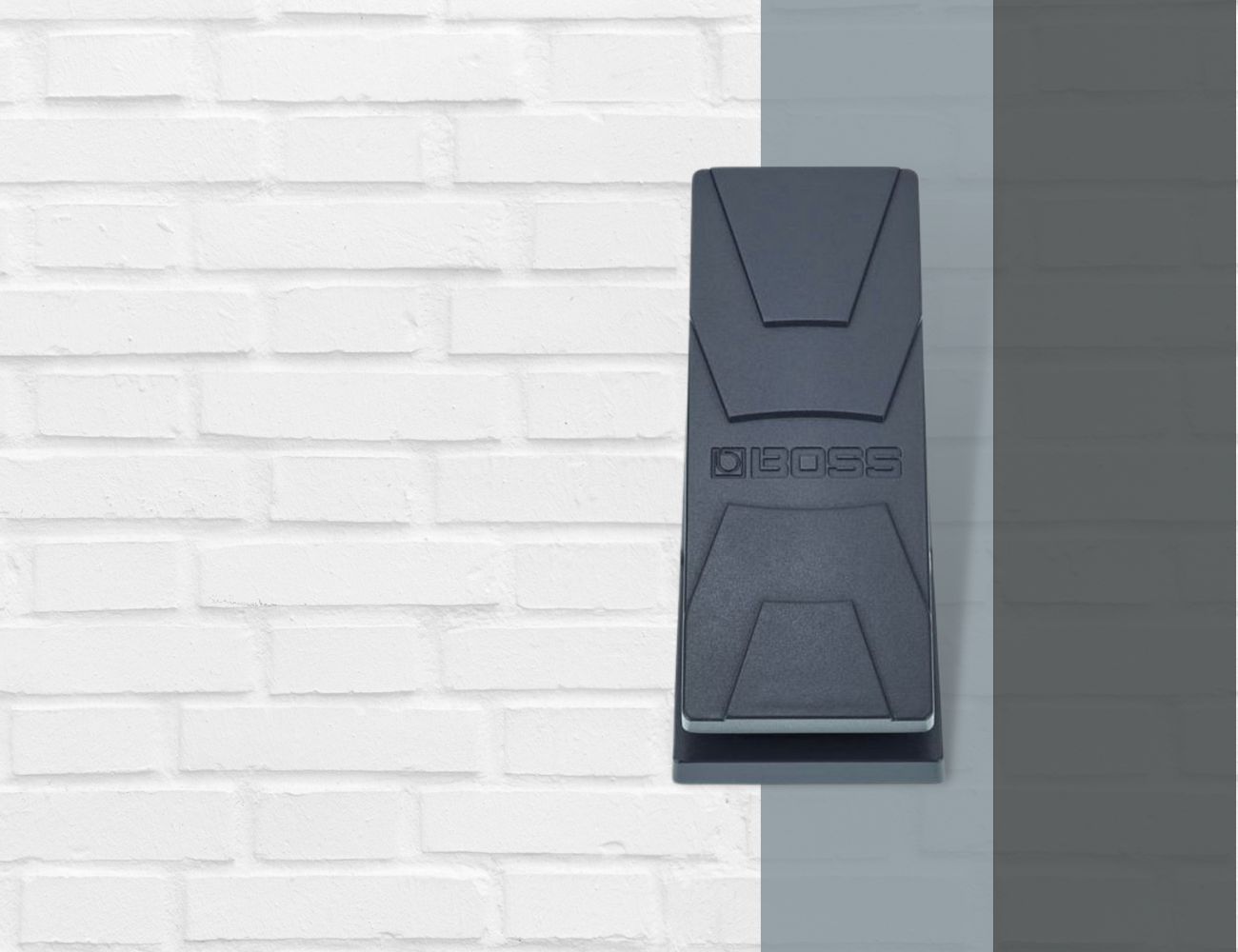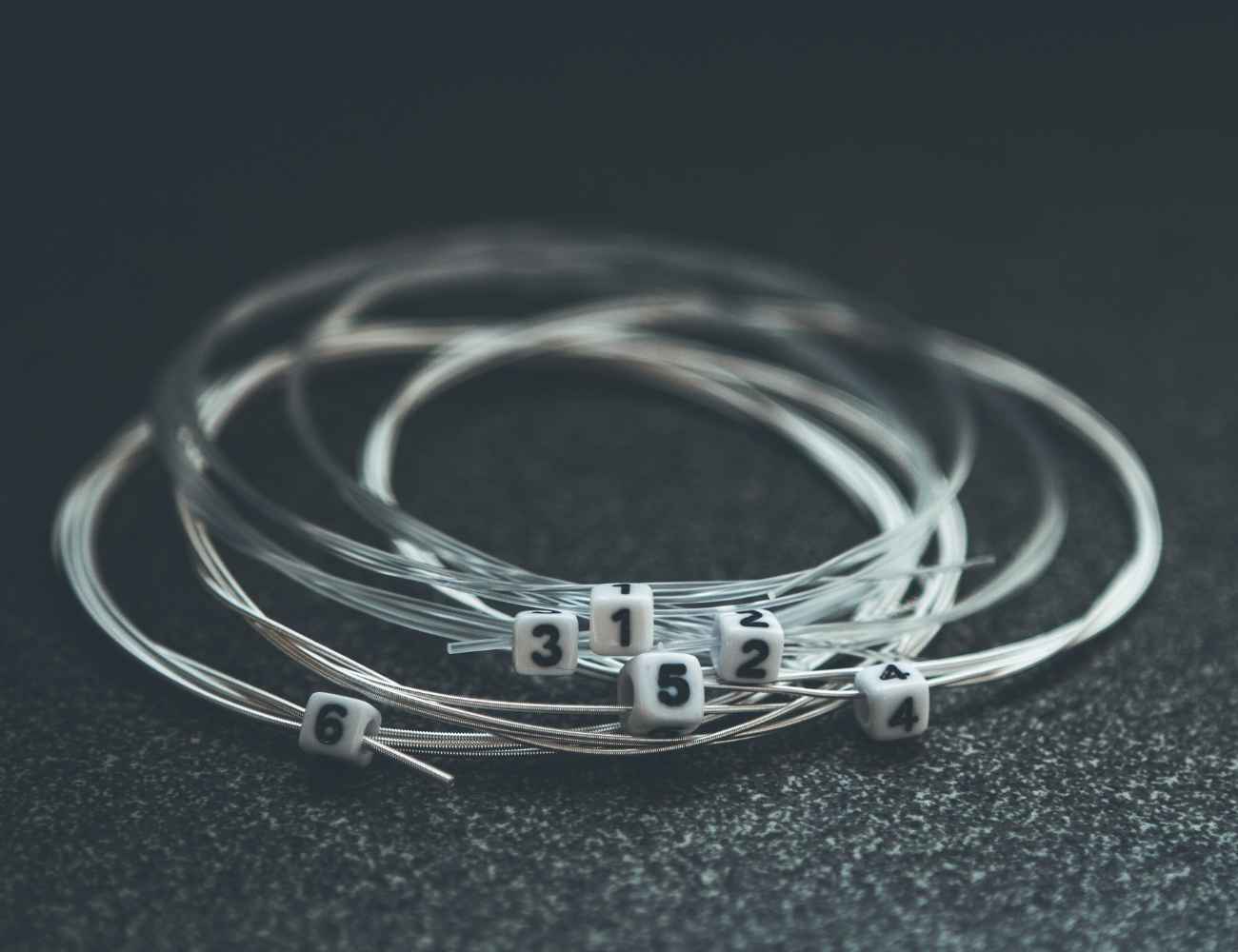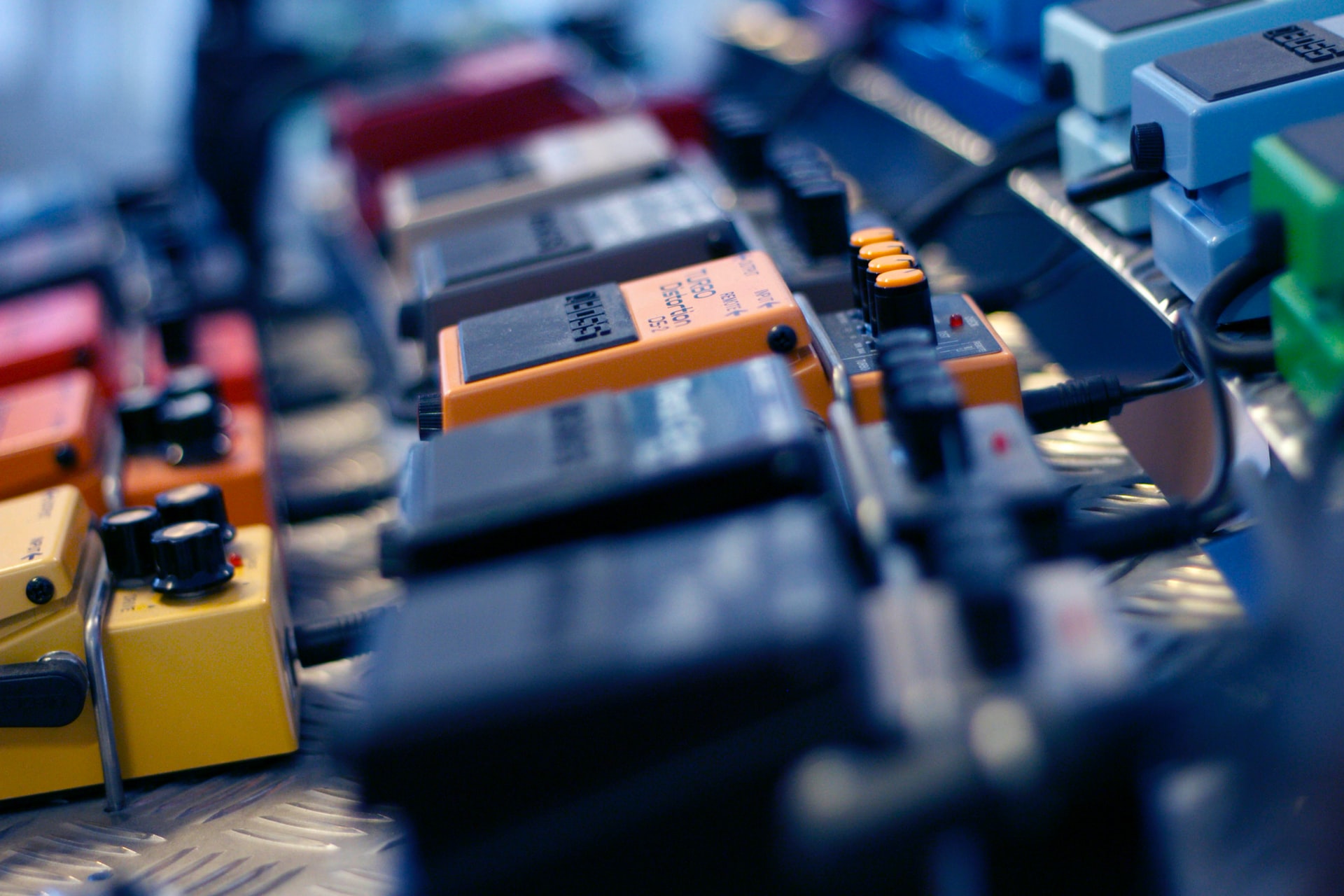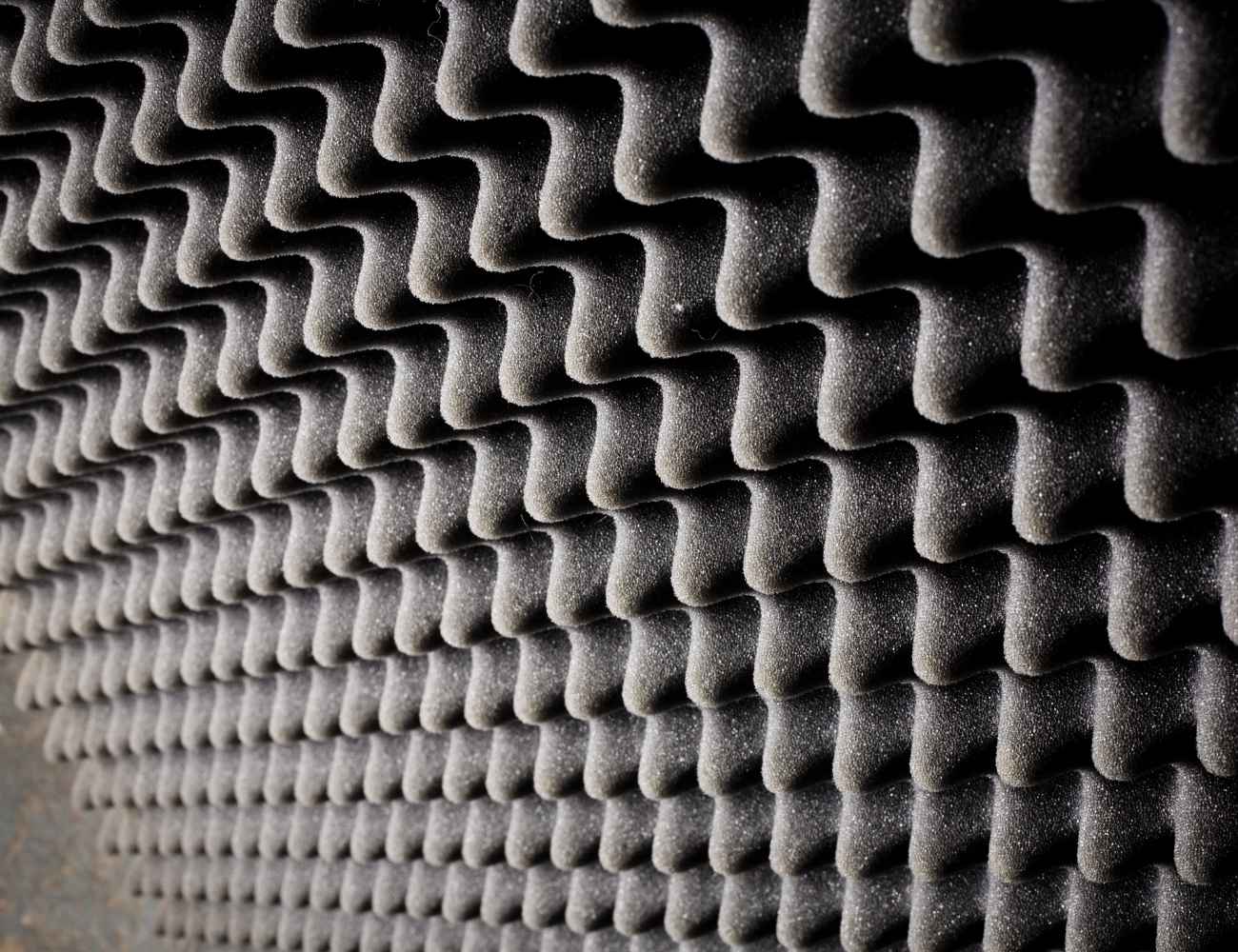Ever been in the heat of a guitar solo when you realize the tone just isn’t right?
Or maybe you’re an aspiring guitarist, and you’re struggling to find that perfect balance between volume and effect.
Expression pedals could be the game-changer you’re looking for!
These clever devices allow you to take control, fine-tune your sound, and bring your musical vision to life.
But here’s the catch: not all expression pedals are created equal.
In this blog post, we’ll guide you through the maze of the best expression pedals, breaking down their key features, strengths, and how they can elevate your playing experience.
Table of Contents
- Best Expression Pedals
- M-Audio EX-P Expression Pedal
- Boss EV-30 Dual Expression Pedal
- Zoom FP-02M Expression Pedal
- Behringer FC600 V2 Expression Pedal
- Boss EV-5 Expression Guitar Pedal
- Mission Engineering SP-25-Pro-Aero Expression Pedal
- Yamaha FC7 Volume Expression Pedal
- Fender Tread-Light Volume/Expression Pedal
- Line 6 EX-1 Expression Pedal
- Mission Engineering EVENTIDE SP-H9 Expression Pedal
- MeloAudio EXP-001 Expression Pedal
- Electro-Harmonix Single Output Expression Pedal
- MOOER Expline Guitar Expression Pedal
- Digitech Guitar Expression Pedal
- Mission Engineering Inc SP-1 Expression Pedal
- Nektar NX-P Expression Pedal
- Moog EP-3 Expression Pedal
- What exactly is an expression pedal?
- What to consider when choosing an expression pedal?
- How to properly use an expression pedal?
- How to order pedals on a pedalboard?
- Boutique vs. Mass-Produced pedals
- How much should you spend on a guitar pedal?
- Can you use a guitar pedal with a bass guitar?
- How to properly power your pedals?
Best Expression Pedals
Before I begin, here are my top selected choices:
M-Audio EX-P Expression Pedal

M-Audio’s EX-P expression pedal for creative expression and reliable performance. Check Price
|
|
Nektar NX-P Expression Pedal

Solid, reliable expression pedal with polarity switching for universal compatibility. Check Price
|
M-Audio EX-P Expression Pedal
M-Audio’s EX-P expression pedal for creative expression and reliable performance.
M-Audio’s EX-P Expression Pedal offers universal compatibility and robust, reliable performance, allowing you to control and manipulate any MIDI assignable control or parameter in real-time. It features a compact design and smooth pedal action for a seamless studio or on-the-go experience.
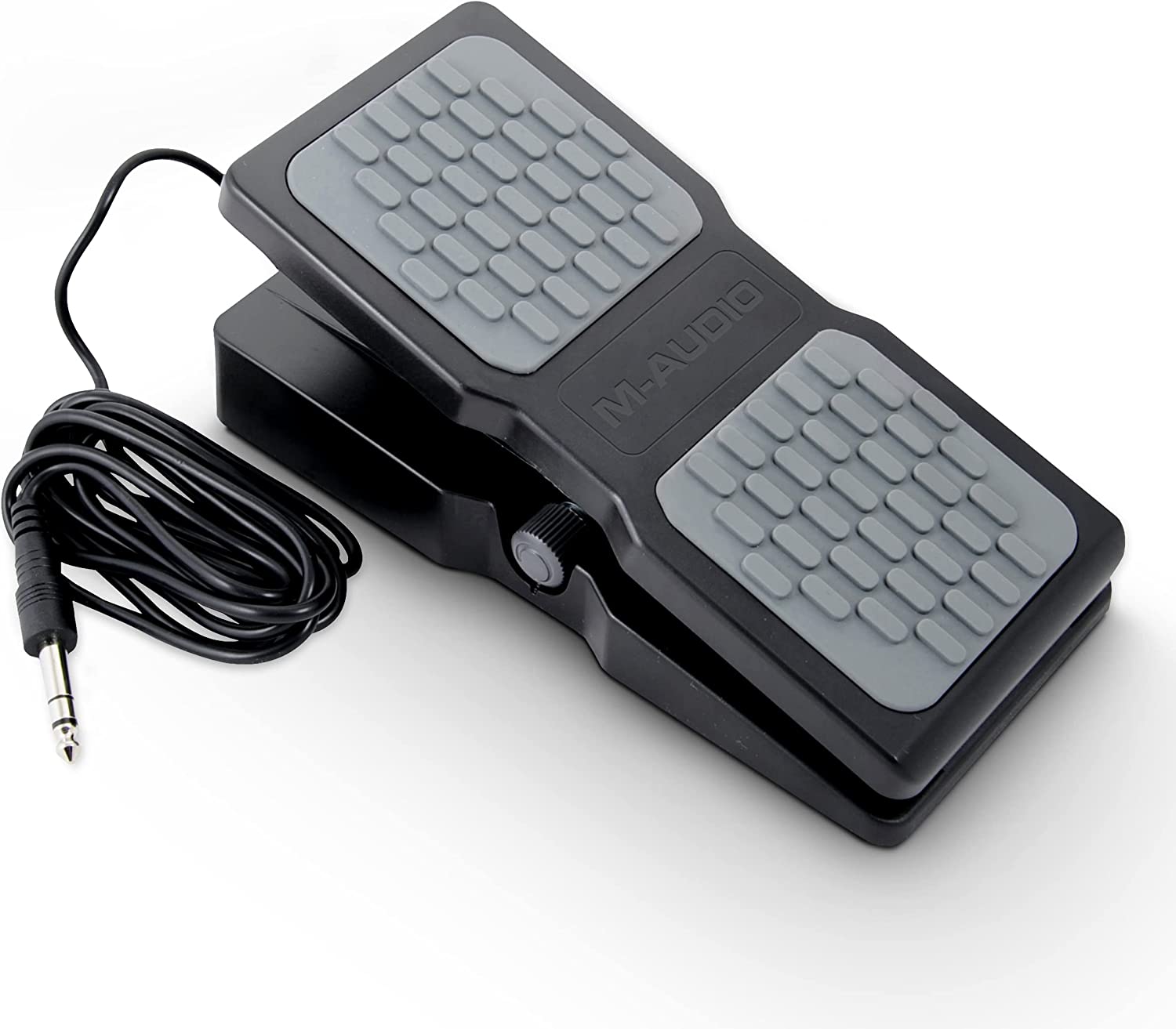
M-Audio’s EX-P Expression Pedal is a versatile piece of equipment for any musician seeking a broader range of creative possibilities with their MIDI keyboards, controllers, or compatible guitar effect pedals.
This universal pedal allows real-time manipulation of any MIDI control or parameter, including volume, modulation, panning, or filter sweep, which essentially lets your creativity take the driver’s seat.
Designed with wide compatibility in mind, the EX-P Expression Pedal features a hidden polarity switch, making it usable with many keyboards, controllers, synthesizers, and other devices with an expression pedal input.
It boasts a robust construction and a securely hardwired 1/4-inch 18m TRS cable to fit industry-standard expression pedal inputs.
Despite its durability, this pedal maintains a compact, lightweight build, making it conveniently portable.
It features a textured footrest for stable use and a wide-angled action for precise, expressive control.
Moreover, it’s an offering from M-Audio, a trusted name in musical hardware.
- My Review
Stepping on the M-Audio EX-P Expression Pedal for the first time, I immediately appreciated its textured footrest.
It ensures that my foot doesn’t slip mid-performance, allowing me to stay focused on the music rather than constantly adjusting my foot placement.
It’s a small detail but certainly significant in a live performance scenario.
Its wide-angle action immediately stood out to me.
With each foot movement, I could precisely control various parameters from volume to modulation, offering my music a new dimension of expressiveness.
Whether I was tweaking a synthesizer filter or adjusting the volume on a MIDI keyboard, the pedal responded instantly and accurately to my inputs.
I also found the universal compatibility of the EX-P to be a considerable asset.
I tested it with various keyboards and controllers and even a few guitar effects pedals – each time, the pedal proved a reliable companion.
Its built-in polarity switch ensures compatibility with various musical devices, making it an adaptable piece of gear in my studio.
Despite its robustness, the pedal is lightweight and compact, an attribute I found immensely helpful when packing for gigs or simply moving around my studio.
I also commend the hardwired 1/4-inch 18m TRS cable – it’s sturdy and fits perfectly into standard expression pedal inputs.
However, one area of improvement could be the size of the pedal.
While its compact nature is generally a plus, I found it slightly undersized for my larger footwear.
Here are the ratings I’ll give to the M-Audio EX-P Expression Pedal:
M-Audio has put a lot of thought into the EX-P Expression Pedal.
It provides a superb blend of precision, versatility, and durability, making it a valuable addition to any musician’s toolkit.
- Pros:
- Expand creative scope of your controller/keyboard.
- Real-time control of MIDI assignable parameters.
- Universal compatibility with various keyboards and devices.
- Secure and robust construction.
- Compact and lightweight for portability.
- Cons:
- Limited compatibility with certain guitar effects pedals.
- Potential durability issues with the foot-rest over time.
- May lack additional advanced features compared to other expression pedals.
My final verdict is that the M-Audio EX-P expression pedal is a versatile and feature-rich option for musicians seeking real-time control over MIDI-assignable parameters.
With its universal compatibility and robust construction, it offers reliable performance.
The M-Audio brand is well-respected in the audio industry, further adding to its appeal.
While its impact on tone may vary, the pedal provides a solid value proposition overall.
Considering its positive attributes, I believe the M-Audio EX-P expression pedal is recommended for musicians looking to expand their creative capabilities.
Boss EV-30 Dual Expression Pedal
Compact, dual-output expression pedal with ultra-smooth feel and reliable performance.
The BOSS EV-30 is a compact dual expression pedal with internal mechanism for ultra-smooth feel and precise control. It features two electronically isolated expression outputs and polarity switch for compatibility with many music devices.
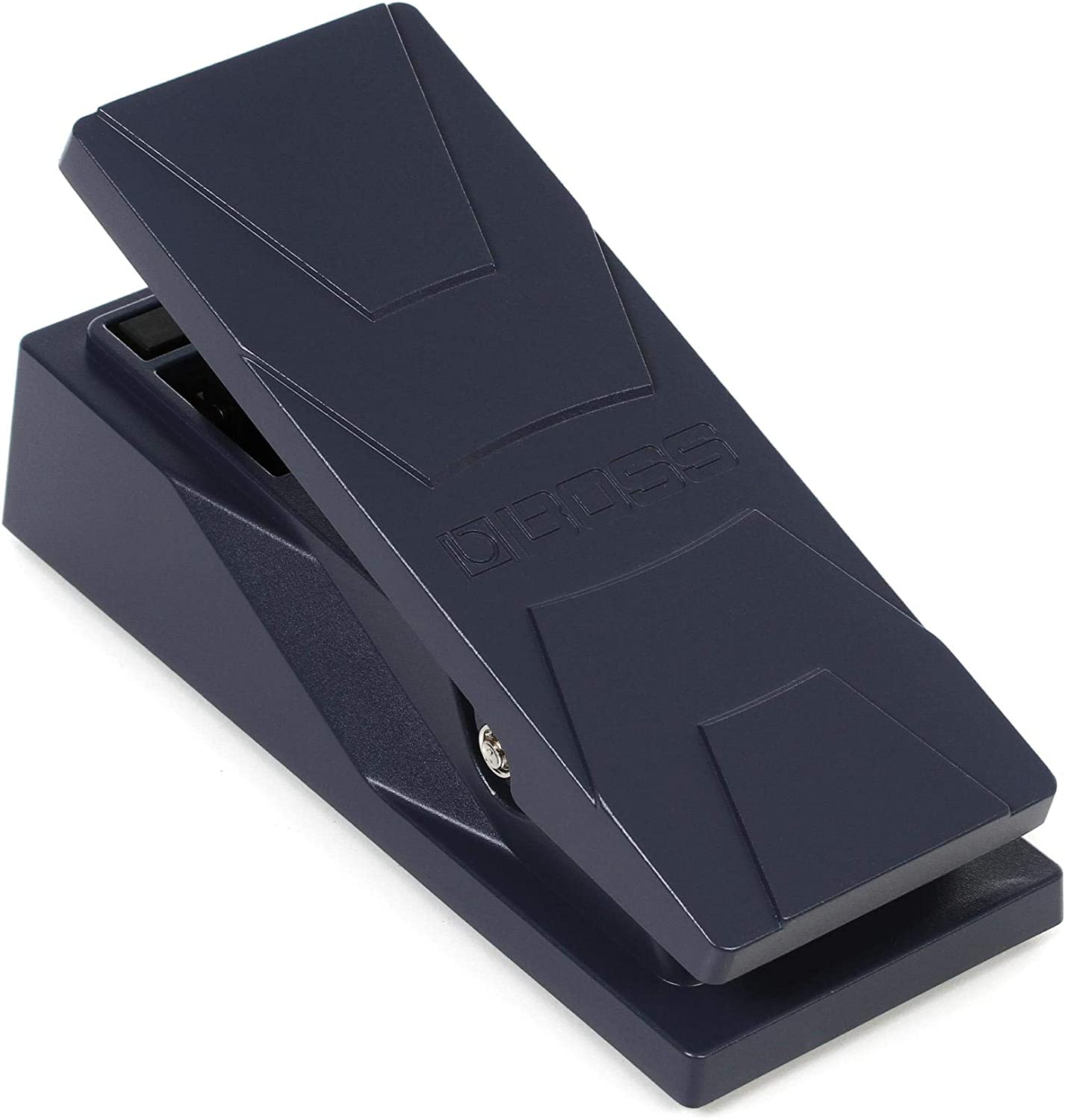
Meet the Boss EV-30 Dual Expression Pedal, your go-to gadget for professional-grade expression control in a small, compact form.
This neat device is designed to be pedalboard-friendly and saves you much-needed space without compromising on quality.
What sets it apart? Its unique internal mechanism is built to deliver ultra-smooth, precise parameter adjustments comparable to those from full-size pedals.
But there’s more.
The EV-30 stands out with its dual expression outputs, allowing control of two separate devices from just one pedal – a fantastic feature for those aiming to maximize pedalboard economy.
Its cast-aluminum construction guarantees stability and durability, staying true to Boss’s well-known reliability.
One of its additional benefits is the inbuilt polarity switch that ensures compatibility with a wide variety of music gear.
Hence, it can be used with most equipment supporting expression control.
With the EV-30, get ready to enjoy real-time parameter adjustments on many Boss compact pedals, multi-effects processors, and effects switching systems.
This pedal is about enhancing your musical expression in the most space-efficient way possible.
- My Review
Diving right into the heart of my experience with the Boss EV-30 Dual Expression Pedal, I can confidently say it hits the nail on the head with its promise of a compact yet power-packed performance.
It’s impressive how much functionality they’ve managed to squeeze into such a small footprint.
Having hands-on experience with the EV-30, I particularly appreciate its innovative internal mechanism.
It offers an ultra-smooth feel and pinpoints precision in parameter control, closely mimicking the finesse of full-sized pedals.
Few compact pedals can boast such precision and smoothness, making the EV-30 a real standout.
What took me by surprise was its dual expression outputs.
This feature allows control over two devices simultaneously from just one pedal, a smart design choice considering the often cramped state of pedalboards.
It’s fresh air to see a pedal that understands and caters to the needs of those tight on space.
Crafted from die-cast aluminum, the EV-30 exhibits a sturdy build.
This is in line with Boss’s reputation for durability and rugged reliability.
I can vouch for the pedal’s robustness; it feels rock-solid, unfazed by countless hours of jamming.
Now, let’s talk about compatibility.
With its handy polarity switch, the EV-30 offers wide-ranging compatibility.
It readily integrates with most devices supporting expression control, freeing me from the hassle of checking gear compatibility every time.
And yet, I must mention a potential point of improvement.
While the EV-30 is highly practical, some might find it lacking the ‘wow’ factor in design.
However, this subjective preference does not impact its top-notch performance.
Here are the ratings I’ll give to the Boss EV-30 Dual Expression Pedal:
The Boss EV-30 Dual Expression Pedal delivers on its promise: professional expression control in a space-saving, reliable, and compatible package.
It’s a compact powerhouse that doesn’t compromise on performance, making it a valuable addition to any musician’s toolkit.
- Pros:
- Compact size for cramped pedalboards.
- Precise parameter control with ultra-smooth feel.
- Two expression outputs for controlling multiple devices.
- Electronically isolated outputs for noise reduction.
- Cons:
- Relatively high price compared to other options.
- Limited compatibility with non-BOSS devices.
- No additional features or built-in effects.
My final verdict is that the Boss EV-30 Dual Expression Pedal is a highly versatile and performance-oriented with a solid brand reputation.
Its two expression outputs offer precise parameter control and the convenience of controlling multiple devices.
The compact size and durable construction make it suitable for cramped pedalboards.
However, it may have limited compatibility with non-BOSS devices, and the price could be considered relatively high compared to other options.
Considering its features, performance, and brand reliability, the Boss EV-30 earns a positive recommendation for those seeking a compact and reliable expression pedal.
Zoom FP-02M Expression Pedal
Smooth, durable expression pedal for Zoom processors.
This expression pedal offers durable construction and adjustable footboard angle for comfortable use. It has a low-noise design and an aluminum alloy base for excellent stability and firm grip on the floor.
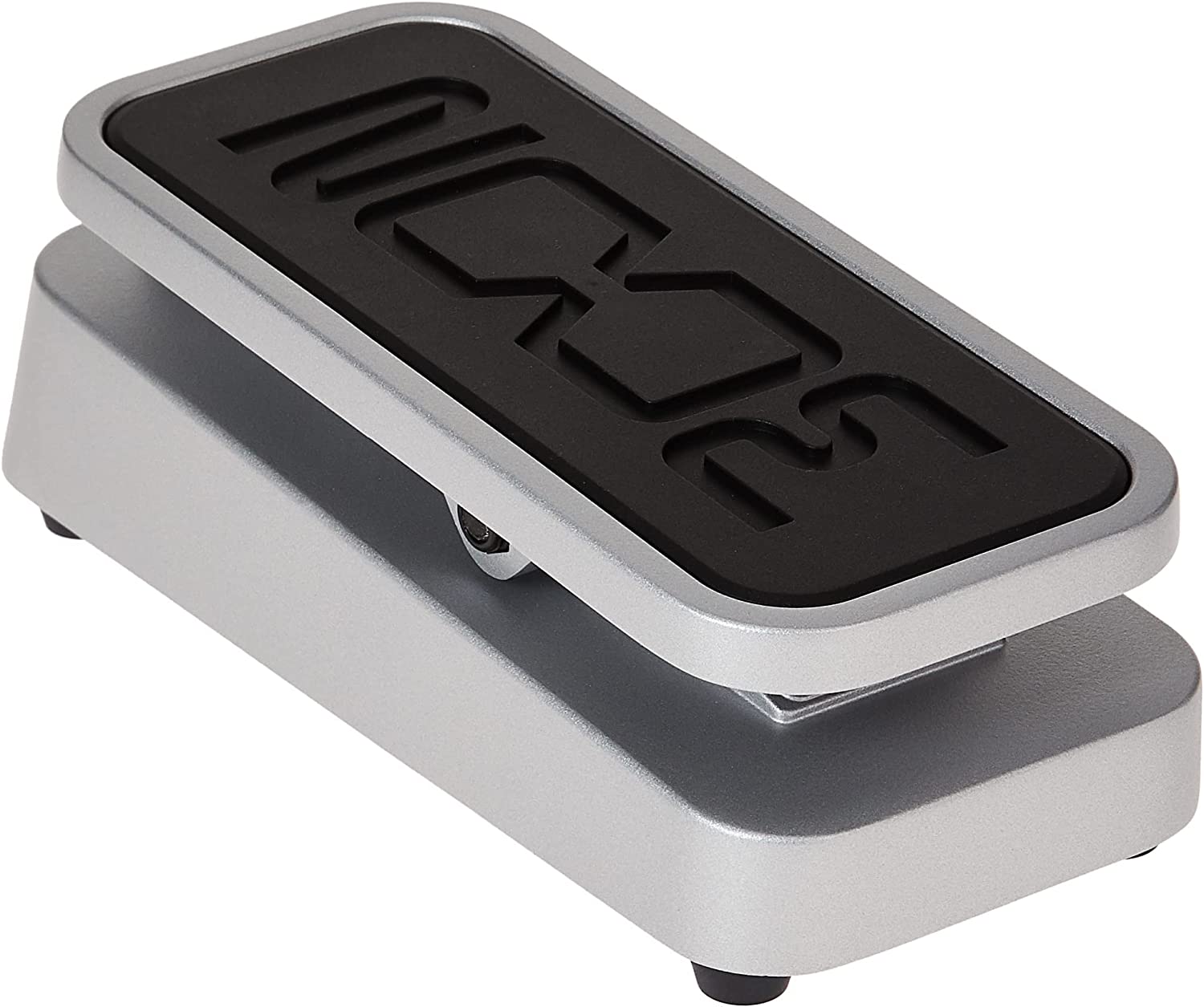
Presenting the Zoom FP-02M, a sturdy expression pedal crafted to pair harmoniously with all Zoom Multi-effects Processors, such as the renowned G3n, G3Xn, G5n, and B3n models, among others.
Its broad compatibility doesn’t end there, as it interfaces seamlessly with Zoom 500 Series, 234, 323, 3030, 1010, 2100, MRS1044, and various other units.
Notably, this edition features a metal design, a substantial upgrade that enhances durability.
This essential tool hails from China, carrying with it a reputation for precision engineering and robust build quality.
Subtle shades of silver and black color the FP-02M, giving it a sleek aesthetic appeal.
The pedal, weighing a mere 1.8 pounds, strikes an impressive balance between heft and portability.
Its compact dimensions – 10 by 3.2 by 4 inches – allow it to fit comfortably into any rig.
It operates at a voltage of 9 volts, ensuring low power consumption.
This is your Zoom FP02M Expression Pedal, a trustworthy ally in the pursuit of tonal control and dynamic expression.
- My Review
I’ve had the chance to explore the Zoom FP-02M Expression Pedal, and it’s certainly worth talking about.
Upon first inspection, I appreciated its modern aesthetic – the silver and black color scheme, combined with a sturdy metal build, creates a visually appealing tool that doesn’t skimp on durability.
I was delighted to discover the wide compatibility of this pedal.
It played nicely with all Zoom Multi-effects Processors I could throw at it.
The names G3n, G3Xn, G5n, and B3n are not just alphabet soup; these models, and many others, are being paired harmoniously with the FP-02M.
It also coexisted well with the Zoom 500 Series, 234, 323, 3030, 1010, 2100, MRS1044, and even more units.
This versatile compatibility makes it an excellent addition to various audio setups.
While using the FP-02M, I appreciated its portability and compact size.
Weighing only 1.8 pounds and having dimensions of 10 x 3.2 x 4 inches, carrying it around or fitting it into my gear was no burden.
That being said, it isn’t without its drawbacks.
The 9-volt power requirement, while not overly demanding, might be a minor inconvenience for those who are used to rechargeable or lower-voltage gear.
Nevertheless, the robust build quality and versatile compatibility outshine this minor limitation.
Considering this, the Zoom FP-02M is a reliable, well-constructed, and versatile tool.
Here are the ratings I’ll give to the Zoom FP-02M Expression Pedal:
While it might require a minor adjustment in terms of power supply, its overall performance and durability are undeniably impressive.
It’s a noteworthy pedal for those looking to achieve dynamic control and a greater range of expression in their music.
- Pros:
- Durable metal construction.
- Compatible with various Zoom effects processors.
- Wide compatibility with other Zoom units.
- Cons:
- Limited color options (only available in silver and black).
- Relatively large dimensions (10 x 3.2 x 4 inches).
- Requires a 9-volt power supply.
My final verdict is that the Zoom FP-02M Expression Pedal is a highly versatile and feature-rich option for users of Zoom effects processors.
With its durable metal construction and wide compatibility, it offers great performance and delivers a solid tone.
Although it has limited color options and relatively large dimensions, these factors are overshadowed by its overall value.
Considering its positive attributes, I recommend the Zoom FP-02M Expression Pedal to users seeking a reliable and versatile expression pedal for their Zoom multi-effects processors.
Behringer FC600 V2 Expression Pedal
Smooth volume/expression control with adjustable torque and tuner output.
The FC600 is a heavy-duty foot pedal for volume and expression control, allowing you to quickly shift from rhythm to lead levels or create amazing ambience. It features a tank-tough construction and adjustable pedal feel for reliable, ultra-smooth performance.
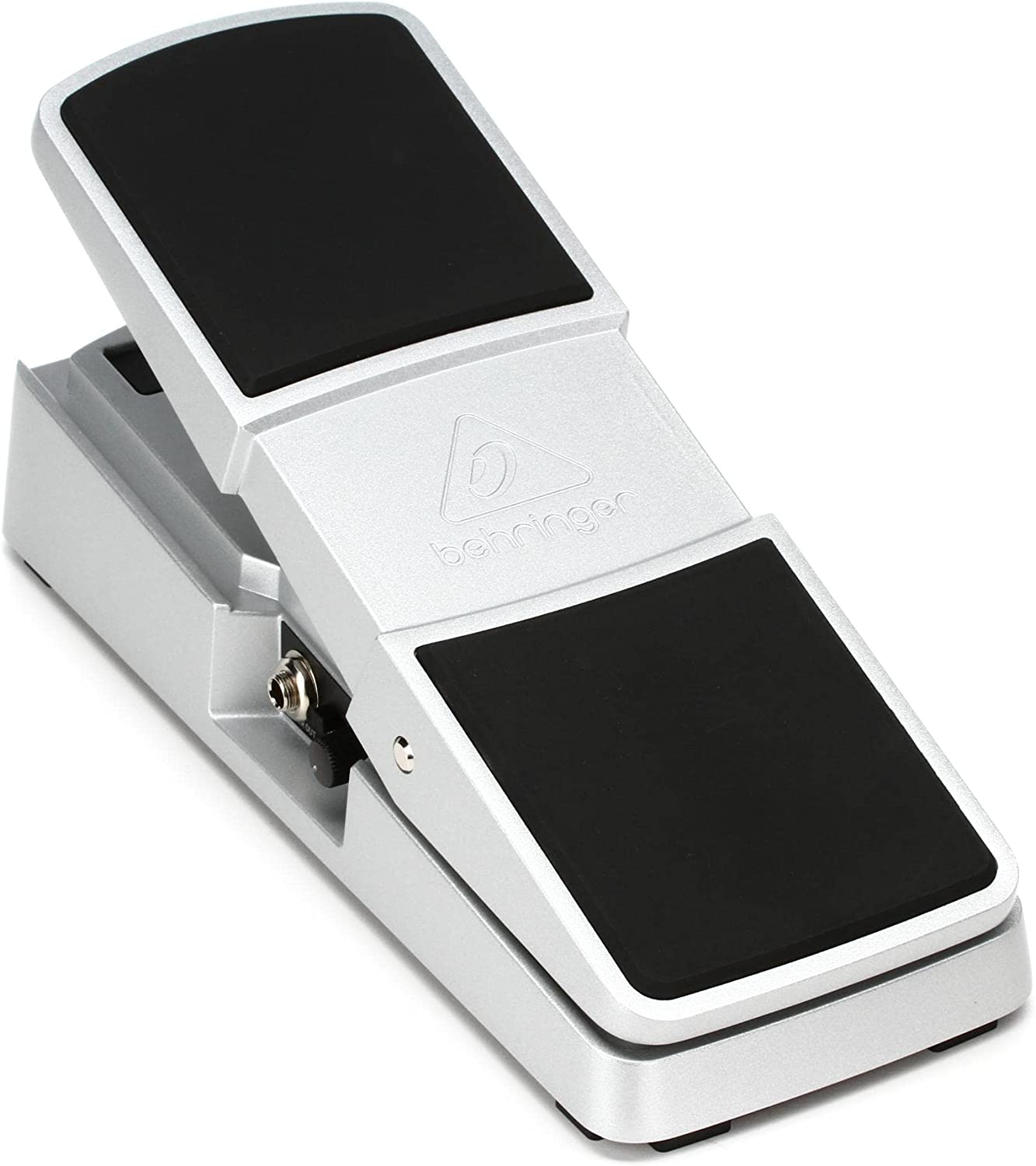
Behringer’s FC600 V2 is more than your regular expression pedal.
With a body made of die-cast metal, this sturdy pedal offers dual functionality of volume control and expression modulation, making it quite versatile.
It’s designed for high-impedance instruments like guitars and keyboards, assuring optimal signal integrity.
Its footboard has a rubberized finish for a non-slip action, providing comfort and better control during your performances.
It also features an adjustable minimum volume control, so you can match it to your rhythm level or set it to zero for those incredible volume swells.
The pedal also has a unique feature – reversible polarity – adding to its versatility.
An additional tuner output for silent tuning ensures your music stays pitch-perfect.
It’s compact, with dimensions measuring 11.73 x 4.41 x 2.76 inches, and weighs around 1440 grams, making it portable and perfect for on-the-go musicians.
- My Review
Stepping onto the Behringer FC600 V2 Expression Pedal for the first time, my immediate impression was of its solid build.
Its die-cast metal body was reassuringly sturdy, reflecting the pedal’s heavy-duty intention.
The footboard, designed with a rubberized texture, added an appreciated layer of non-slip comfort and a tactile connection to the performance.
Working with various high-impedance instruments, the FC600 V2 was a delight.
It served as a faithful control panel for my sound, with its dual volume and expression modulation functionality.
Shifting from rhythm to lead levels using my feet quickly freed my hands, letting me focus solely on my performance.
The adjustable minimum volume control was a clever feature.
It allowed for fine-tuning the volume according to my preference, from matching my rhythm level to setting it at zero.
I found the latter setting great for creating captivating volume swells that added an ethereal quality to my music.
However, I found that the expression aspect of the pedal needed improvement.
The pedal’s modulation effect had an unexpectedly large dead zone, making it difficult to gauge the extent of modulation based on foot position.
This was a significant drawback for me, and I hope Behringer can address it.
The silent tuner output was another smart addition, allowing me to keep my instrument in tune without distracting from the performance.
The Behringer FC600 V2 Expression Ped offered impressive utility and comfort despite its minor flaws.
Here are the ratings I’ll give to the Behringer FC600 V2 Expression Pedal:
The robust construction and versatile features made it a reliable companion on stage and in the studio.
It’s far from perfect, but its strengths more than compensate for its weaknesses.
- Pros:
- Sturdy die-cast metal body.
- Reversible polarity for versatile usage.
- Adjustable torque for personalized feel.
- Tuner output for silent tuning.
- Cons:
- Possible deadzone in modulation effect.
- Potential creaking sound over time.
My final verdict is that the Behringer FC600 V2 Expression Pedal offers a range of features, including a sturdy metal body, reversible polarity, adjustable torque, and a tuner output.
However, considering the lack of positive reviews and the potential issues mentioned in the critical review, such as a possible dead zone in modulation effect and creaking over time, it is advisable to explore alternative options before purchasing.
Boss EV-5 Expression Guitar Pedal
Dynamic performance with customizable minimum volume.
EV-5 Expression Pedal provides a dynamic performance with adjustable minimum volume, perfect for use with keyboards and other Expression-compatible instruments and devices.
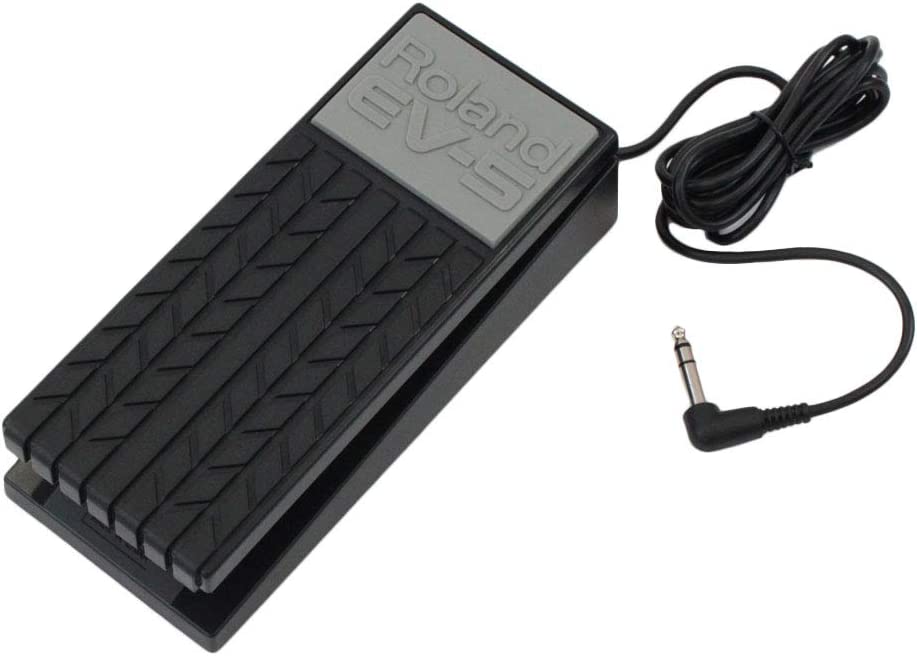
Crafted by Roland, a name synonymous with quality in music, the BOSS EV-5 is a solid and dependable expression pedal, primarily for guitarists.
Its robust construction ensures it can withstand the rigors of live performance.
Sporting an all-black design, this pedal functions well and blends seamlessly into any gear setup.
The EV-5’s principal role lies in its capability to inject dynamic expression into your performance, an essential asset for keyboards or any other expression-compatible instruments.
It gives you the unique advantage of setting the minimum volume per your preferences and defining the pedal’s maximum effect.
Don’t be fooled by its compact dimensions of 9 by four by 3 inches.
This powerhouse is in a small package, weighing just 0.2 grams, making it easy to carry and set up.
Whether in a studio or on a stage, the EV-5 Expression Pedal by Roland is a reliable companion for delivering memorable performances.
- My Review
First, let’s talk about Roland’s BOSS EV-5 Expression Guitar Pedal.
What struck me immediately was the sleek black design that subtly states its presence.
There’s something about how it blends seamlessly into the gear setup – no pretension, just rock-solid performance.
Placing my foot on the pedal, I felt the quality of the construction. It’s heavy-duty, alright, built like a tank.
I could count on that during those wild, energetic performances where I’d hate a gear failure.
It’s not the lightest pedal on the block, but that’s a trade-off I’m willing to make for durability.
The unique selling point for me, however, was the adjustable minimum volume feature.
It’s not something you see in every expression pedal, which sets the EV-5 apart.
The pedal allowed me to determine the level of effect it has on the sound, providing me with a layer of customizability that enhanced my performance to a great extent.
The pedal is compact, fitting comfortably in my gear bag. Despite the compact size of 9x4x3 inches, it didn’t skimp on functionality.
This pedal could take a good stomping and then some, yet, at 0.2 grams, it wasn’t a weight burden.
Using the EV-5, I felt an enhancement in the dynamic range of my performance.
And that’s what we all want.
More control, expression, and freedom to bring our music to life.
But it’s not all roses. For one, the color options are limited.
Some might argue that color doesn’t affect performance, but a little personality wouldn’t hurt.
Here are the ratings I’ll give to the Boss EV-5 Expression Guitar Pedal:
Also, the pedal can be a bit stiff initially, but it eases up with usage.
The BOSS EV-5 Expression Guitar Pedal is a fantastic tool, bringing an added layer of control and expression to performances, despite minor setbacks.
- Pros:
- Compact size.
- Durable construction.
- Responsive control.
- Cons:
- Limited compatibility.
- No built-in effects.
- May require additional cables.
My final verdict is that the BOSS EV-5 Expression Guitar Pedal is a solid option for musicians seeking a versatile and responsive control pedal.
Its compact size and durable construction offer good performance and reliable Roland quality.
However, the limited compatibility, lack of built-in effects, and potential need for additional cables may be drawbacks for some users.
Considering its overall brand reputation and decent value, the BOSS EV-5 Expression Guitar Pedal can be a reliable choice for musicians looking to enhance their expression capabilities.
Mission Engineering SP-25-Pro-Aero Expression Pedal
Illuminated halo, ergonomic design, dual 25K outputs.
Aero design expression pedal with dual 25K outputs, latching toe switch and sapphire LED for a visible halo effect. The ergonomic design is suitable for standing or seated use, and compatible with MIDI and digital devices.
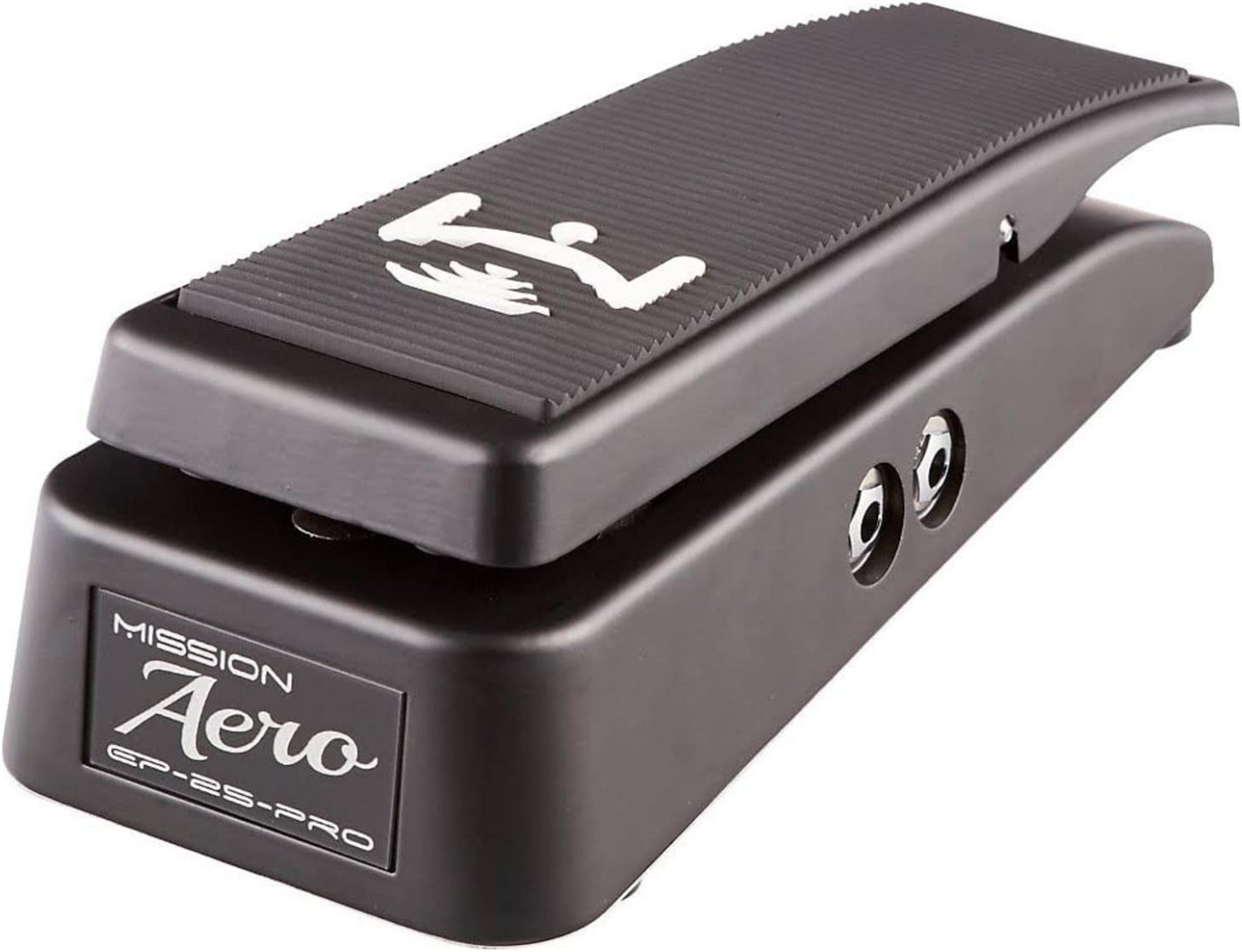
Built by Mission Engineering, the SP-25-Pro-Aero is an expression pedal focusing on volume and effects parameter controls.
Its distinctive feature is the Aero design that provides an extended sweep, making it a versatile choice for many musicians.
This pedal stands out with its thoughtful ergonomic design.
Whether sitting or standing, its rear cut-away and extended-length curved surface offer comfortable usability; it’s not just for guitarists; this device can accommodate keyboards and acoustic instruments, too, making it an asset in live performances and studio sessions.
One nifty aspect of this pedal is the inclusion of a dual 25K output with polarity selection, plus a TS Latching switch.
However, what catches the eye is the ultra-bright sapphire LED and acrylic base.
When you hit the toe switch, the pedal lights up in an illuminated halo effect, visible from almost any position.
Furthermore, if you’re using compatible MIDI controllers and digital devices, this lit base can give you a visual cue about the status of a remote effect.
- My Review
Delving into the world of the SP-25-Pro-Aero Expression Pedal by Mission Engineering, it’s evident that this is a tool designed with serious musicians in mind.
Its charm and utility lie in its versatility and high-quality components, significantly enhancing its performance.
Navigating through different volume levels or effects parameters, I found the extended sweep provided by the Aero design incredibly intuitive.
It gives me a wider range of control compared to other pedals, which I appreciate.
Also, the ergonomic design, featuring a rear cut-away and extended-length curved surface, makes using it a breeze regardless of whether I’m sitting or standing.
This pedal’s dual 25K outputs with polarity selection impressed me.
It makes it more adaptable to various devices for guitar, keyboard, or acoustic instruments.
Whether I’m jamming out live or tinkering away in the studio, the pedal is an asset, allowing me to explore different sounds.
There’s a TS latching switch that adds to its function.
However, where the pedal truly stands out is its unique aesthetic feature: the ultra-bright sapphire LED and acrylic base.
Activating the toe switch, the pedal becomes an illuminated centerpiece on my pedalboard.
Visible from almost anywhere, it’s more than just a visual treat – it serves a practical purpose, especially when used with compatible MIDI controllers and digital devices.
The illuminated base can indicate the status of a remote effect, adding another level of information during performances or recordings.
Despite its many positives, there’s one downside.
Unfortunately, the pedal requires an external 9VDC 2.1mm center pin power supply, which is not included.
Here are the ratings I’ll give to the Mission Engineering SP-25-Pro-Aero Expression Pedal:
It’s a minor hiccup in an otherwise stellar product, but worth mentioning for those considering making it their next pedal purchase.
In my experience, the SP-25-Pro-Aero Expression Pedal from Mission Engineering is a high-quality, versatile, and ergonomic device that can enhance any musician’s setup with its broad control range and additional features.
- Pros:
- Extended sweep range for versatile use.
- Dual 25K outputs with polarity selection.
- Latching toe switch for convenient control.
- Illuminated halo effect adds visual appeal.
- Cons:
- Relatively large size (8 x 12 x 12 inches).
- Requires external 9VDC 2.1mm power supply (not included).
- May not be compatible with all devices.
My final verdict is that the Mission Engineering SP-25-Pro-Aero Expression/Volume Pedal Black is a highly versatile and feature-rich pedal that delivers excellent performance and tone.
The brand is well-regarded, and the pedal offers good value for its features.
While it may be relatively large and require an external power supply, it offers a great solution for controlling volume and effects parameters.
Considering its positive attributes and the absence of specific cons, I recommend this pedal to musicians seeking a reliable and versatile expression/volume pedal.
Yamaha FC7 Volume Expression Pedal
Smoothly adjust volume and effects with Yamaha’s FC7 pedal.
Yamaha’s Volume Effects Controller provides precise control over volume, expression, and effects with its 10 knobs and high-precision fader. It features two separate inputs and a foot switch input for connecting external devices, and is compatible with both analog and digital devices.
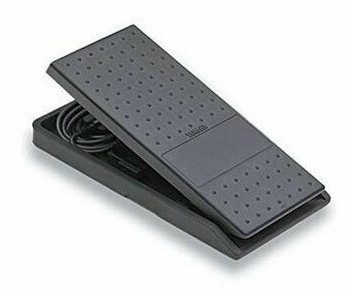
Crafted by Yamaha, the FC7 is your go-to accessory for controlling the volume on your keyboard.
More than just a volume regulator, it allows users to tweak the effects on their instruments, bringing an additional layer of depth to performances.
Its build, both sturdy and heavy-duty, includes a unique “fortissimo function,” which can bring about a spotlight to specific sections of your performance.
This keyboard companion comes with a 5-foot cable and standard 1/4″ jacks, making it a versatile tool that can easily be incorporated into your current setup.
Weighing only 1.5 pounds, it’s not a burden to your gear, while the dimensions of 10.75 x 5.25 x 2.75 inches ensure it doesn’t take up much space.
Designed as a reliable volume control tool for modern electronic keyboards, the Yamaha FC7 is an effects controller that contributes to your creative freedom and musical expression.
Enjoy exploring the musical range with this practical and efficient pedal.
- My Review
Taking a spin with the Yamaha FC7 Volume Expression Pedal, you instantly recognize it’s more than a mere accessory for your keyboard.
Its robust yet practical design reassures you from the get-go.
Its modest 1.5 pounds weight is light enough not to weigh you down, yet it confidently holds its ground during use.
Its dimensions, smartly designed to fit any setup, further underline its practicality.
A single cable extending to 5 feet gives it a versatile reach, and the standard 1/4″ jacks ensure its compatibility with almost any instrument.
Despite these standard features, the FC7’s more unique attributes define its appeal.
One such attribute is the ‘fortissimo function.’ With this, I could emphasize certain parts of a performance effortlessly.
This feature’s potential for dynamic performances is considerable, offering the ability to adjust volume levels in real time and accentuate particular notes for maximum dramatic effect.
More than just a volume regulator, it also offered a chance to modify the effects on my instrument.
This feature was an unexpected delight, enabling me to add a creative flair to my performances.
It’s a game changer for musicians aiming to enhance their expression without being bogged down by complicated tech.
But it wasn’t all roses. Including more detailed instructions would have been nice, as beginners might find some features challenging to grasp initially.
Also, while the build quality is commendable, the overall aesthetics could be sprucing up.
But these are minor quibbles that do not diminish the pedal’s capabilities.
Here are the ratings I’ll give to the Yamaha FC7 Volume Expression Pedal:
When controlling volume and effects for keyboards, the Yamaha FC7 performs admirably.
It’s a reliable, efficient, and powerful companion for musicians seeking to take their performances to the next level.
- Pros:
- Durable and heavy-duty construction.
- Allows volume and effects adjustment.
- Includes “fortissimo function” for accenting performance.
- Cons:
- Relatively high price.
- May require some setup and calibration.
- Cable length may be limiting for certain setups.
My final verdict is that the Yamaha FC7 Volume Expression Pedal for Keyboards is a highly versatile and feature-rich product with excellent tone and performance.
The Yamaha brand is well-regarded, and the pedal provides good value for its price.
Its durable construction and ability to adjust volume and effects, including the “fortissimo function” for accenting performance, are valuable tools for keyboard players.
However, it is important to consider the relatively high price, the need for setup and calibration, and the potentially limiting cable length.
Overall, the Yamaha FC7 Volume Expression Pedal receives a positive recommendation for those seeking a quality volume controller for their electronic keyboards.
Fender Tread-Light Volume/Expression Pedal
Lightweight, durable, and adjustable expression/volume pedal with LED light.
Fender’s Tread-Light Volume/Expression Pedal is a dynamic performance tool, with a switchable LED light for easy visibility and adjustable treadle torque for comfort. Its durable, lightweight anodized aluminum construction with rubberized pad make it perfect for live performances.
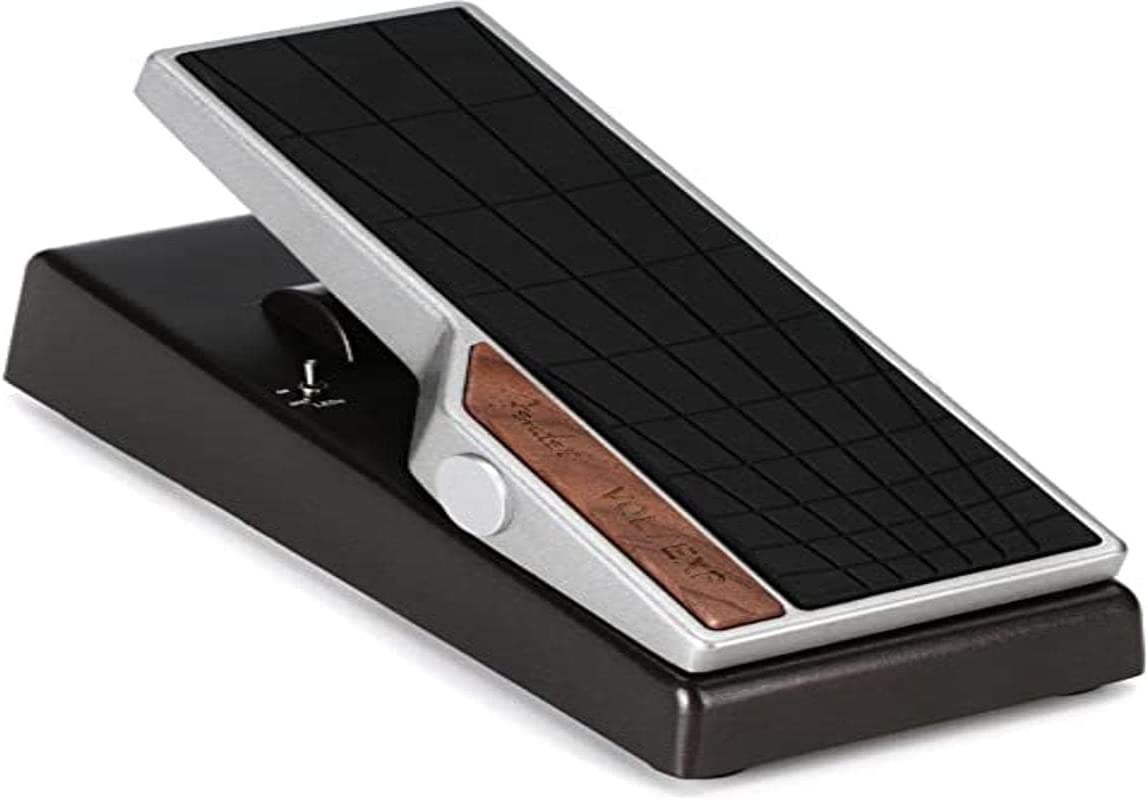
Meet the Fender Tread-Light Volume/Expression Pedal – a marriage of functionality and convenience.
Its three-way adjustable frequency selector is a distinctive feature, making it a versatile tool for any musician.
The under-treadle LED provides visibility, no matter how dim your stage may be.
Built with an internal buffer, it can be switched on or off.
The black-colored, anodized aluminum structure is lightweight yet strong.
Its 9.25 x 3.75 x 2.75 inches dimension means it won’t take up too much space, and at just under two pounds, it’s easy to transport.
Thanks to the top-mounted input and output jacks, you’ll appreciate the adjustable treadle torque for comfort and ease of use.
Powering it is a breeze, courtesy of a center-negative 9VDC connection.
Moreover, its under-treadle light can be easily activated or deactivated with a simple toggle switch.
Fender’s design includes a rubber treadle for that extra style and durability.
Ready for the stage, this pedal offers a perfect blend of quality and functionality.
- My Review
Stepping into the world of the Fender Tread-Light Volume/Expression Pedal, I was engrossed by its novel features.
This gadget truly packs a punch!
Its analog nature shone through, offering me a rich and natural sound experience.
I admired its adjustable three-way frequency selector, which opened up a spectrum of tone-control possibilities, enabling a level of sound manipulation that I hadn’t expected.
Crafted from anodized aluminum, it feels lightweight yet incredibly durable, something I always keep an eye out for.
I relished the convenience of the top-mounted jacks.
They helped keep my setup clean, letting me maximize my pedalboard space.
At just 1.85 pounds, it was a breeze to transport.
Its compact size, just over 9 inches long, added to the convenience factor.
As for comfort, the adjustable treadle torque truly delivered.
Whether I was playing through a mellow, low-key set or ramping it up to an all-out rock performance, my foot found a happy place on this pedal.
In dimly lit environments, the under-treadle LED light became my best friend.
I loved the fact that I could switch it on and off as required, adding a touch of practicality.
It’s also worth mentioning that powering the device was incredibly straightforward, thanks to its center-negative 9VDC connection.
However, I did find the switchable internal buffer a bit confusing initially, but once I got the hang of it, it added a layer of flexibility.
Plus, its rubber treadle provides both style and durability.
Despite being packed with features, the Fender Tread-Light is quite user-friendly.
Here are the ratings I’ll give to the Fender Tread-Light Volume/Expression Pedal:
It takes some experimentation to truly explore its capabilities, but that’s all part of the fun.
This Fender creation is worth considering for those looking for a sturdy, reliable, and versatile volume/expression pedal.
- Pros:
- Analog versatility.
- Adjustable frequency selection.
- Under-treadle LED for visibility.
- Switchable internal buffer.
- Cons:
- Relatively large size.
- Higher weight compared to some alternatives.
- Higher price point.
My final verdict is that the Fender Tread-Light Volume/Expression Pedal is an excellent choice for guitarists looking for a versatile and feature-packed pedal.
Its analog versatility, adjustable frequency selection, under-treadle LED for visibility, and switchable internal buffer offer a range of expression and volume control options.
The brand’s reputation adds to its appeal, and although it may be relatively large and heavier compared to some alternatives, its performance and tone make up for it.
Considering the overall value, the Fender Tread-Light Volume/Expression Pedal is recommended for guitarists seeking a reliable and versatile addition to their pedalboard.
Line 6 EX-1 Expression Pedal
Smoothly control wah/volume with Line 6 EX-1 Expression Pedal.
Line 6’s expression pedal provides smooth morphing between two settings of a modeler, and can also be used for wah or volume on the AX2. It features a 1/4 inch jack and includes a connecting cable, plus is compatible with any 1/4 inch cable for longer runs.
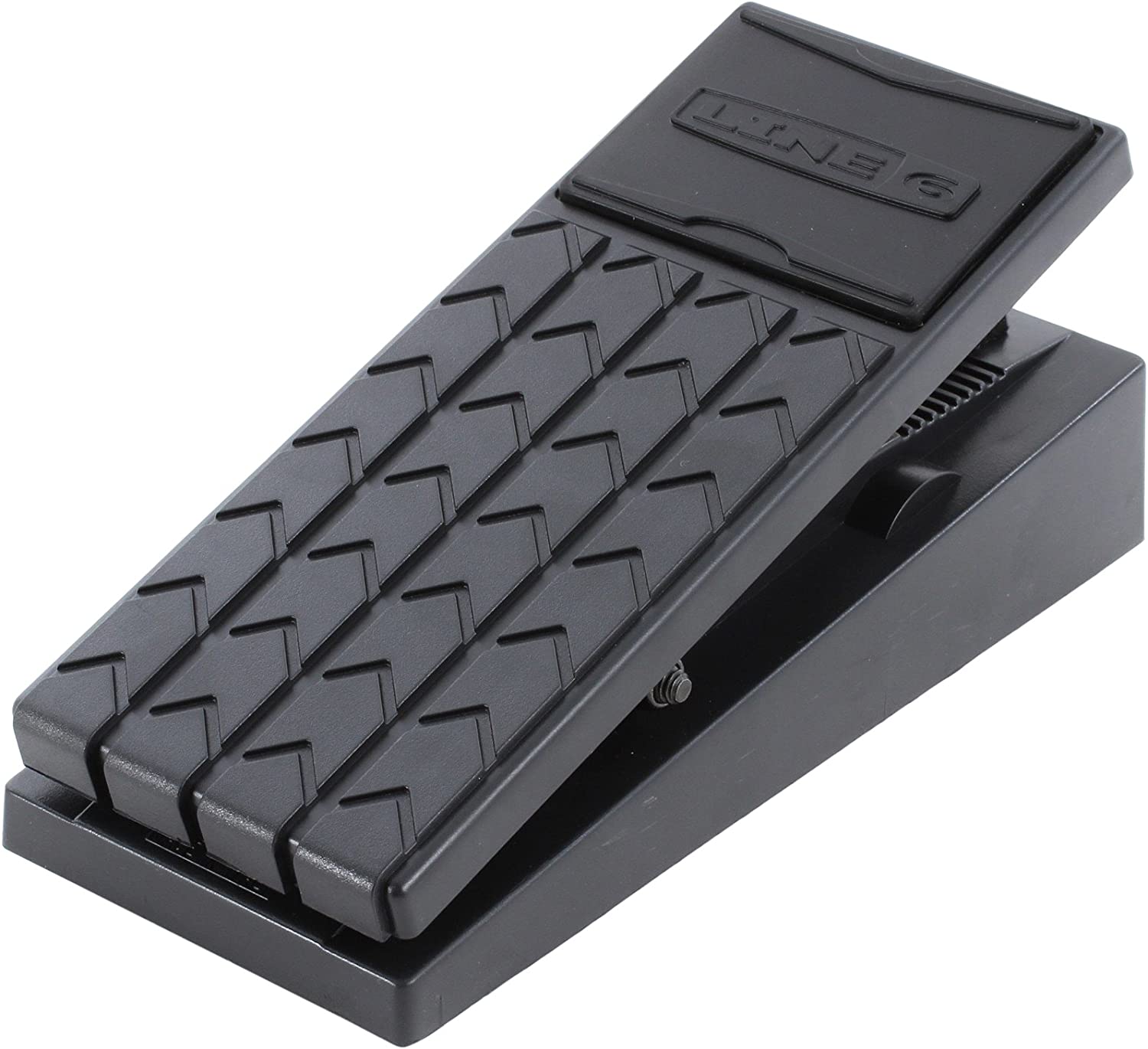
Crafted by Line 6, the EX-1 Expression Pedal is an innovation designed to work harmoniously with Stomp Box Modelers and the AX2.
This pedal empowers you to transition seamlessly between any two settings of a model when used with the Stomp Box Modelers.
In contrast, the AX2 doubles up as either a wah or volume pedal.
Designed for robustness, the EX-1 is enclosed in a sturdy black plastic shell and is adorned with the Line 6 logo.
Despite weighing in at a feather-light one pound, it maintains a compact footprint, measuring 2.75 x 9.5 x 4 inches.
On top of all these features, this pedal flaunts the capability to manage pitch control, generate custom was, and switch between two preset versions.
The included 1/4-inch jack and connecting cable add to the convenience, allowing for extended cable runs if required.
Voltage requirements? Just 9 volts will have you up and running.
- My Review
Stepping onto the Line 6 EX-1 Expression Pedal for the first time, I was aware of its lightweight construction.
Made primarily of black plastic, the durability of the pedal does raise some concerns, particularly if it’s going to see heavy use or rough handling.
That said, my foot found a home easily in its compact form, measuring 2.75 x 9.5 x 4 inches.
Despite the pedal’s short stature, which did leave my toes hanging off the end by a few inches, I found the pitch control and ability to produce custom impressive.
But let’s not forget the two preset versions it offers, adding an extra layer of versatility.
One immediate niggle was the footswitch.
It felt less robust and more toy-like than I would have liked, which was slightly disappointing, considering its role in such a crucial part of my music experience.
I also had some trouble with the included 1/4-inch cable and jack.
The input was snug, perhaps too snug, which could cause issues over time.
Now, it might feel a bit flimsy, but it does deliver when it comes to performance.
Switching between the settings was smooth, and the pedal worked well with the AX2, serving as a volume pedal or a wah with ease.
But don’t be mistaken; it’s a no-frills piece of kit.
It does what it says, and it does it fairly well.
So here’s the rub: the EX-1 is a decent entry-level pedal for those on a budget or just starting.
It’s not perfect, not by a long shot.
Yet, for its price point, it offers a level of functionality and versatility that shouldn’t be ignored.
Here are the ratings I’ll give to the Line 6 EX-1 Expression Pedal:
Yes, it could be better, but it also could be a lot worse.
It’s a cost-effective choice that does its job—nothing more.
- Pros:
- Durable construction.
- Pitch control.
- Custom wahs.
- Cons:
- Plastic build.
- Some quality concerns.
- Not as smooth as desired.
My final verdict is that the Line 6 EX-1 Expression Pedal offers decent versatility, features, and performance.
While it has some quality concerns and may not provide the smoothest experience, its durable construction, pitch control, and custom wahs are noteworthy.
Considering the brand reputation and value for money, it suits those looking for an affordable expression pedal.
Mission Engineering EVENTIDE SP-H9 Expression Pedal
Powerful expression pedal for Eventide effects, with easy setup and portability.
This expression pedal provides precise control over parameters in Eventide stompboxes, with a smooth, high-durability taper and adjustable heel/toe switch. Perfect for customizing your sound and dialing in precise settings.
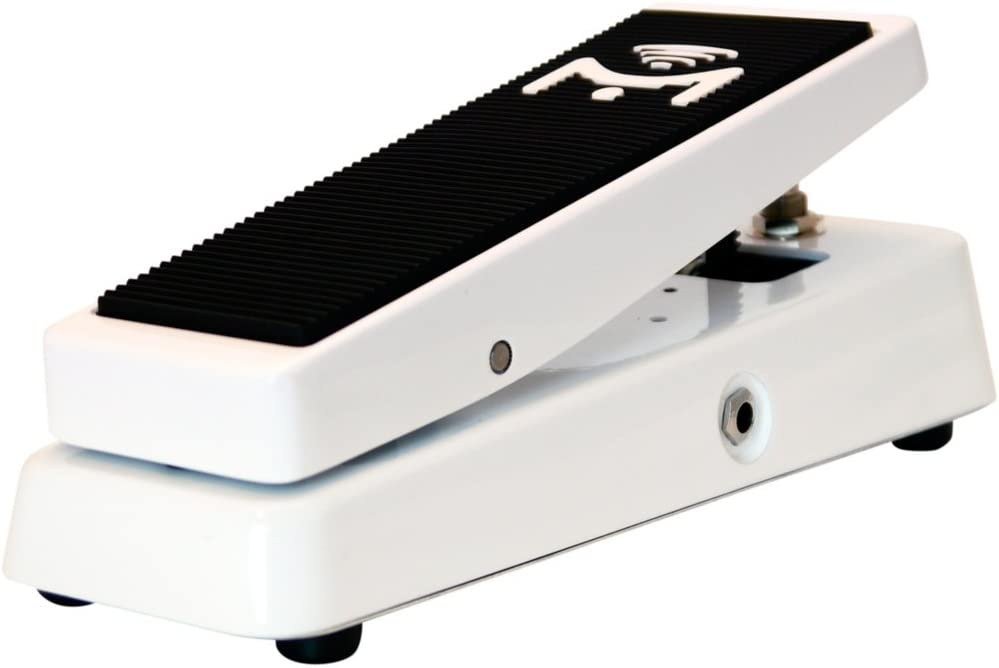
The Eventide SPH9 Expression Pedal, created by Mission Engineering, perfectly blends aesthetics with functionality.
Finished in a clean white color, this expressive device boasts a compact yet sturdy design, measuring about 10.8 by 4.25 by 4.25 inches, so it’s perfect for both compact and larger pedalboards.
Furthermore, its weight of around 3.52 pounds contributes to a solid, stable feel underfoot, ensuring it doesn’t slide around during those intense jam sessions.
Being part of the Expression series, it promises to unlock new levels of control over your effects, delivering smoother transitions and more nuanced performances.
So, whether you’re on a mission to discover uncharted sonic landscapes or keen to inject more emotion into your playing, this offering from Mission Engineering might be the partner you need.
- My Review
Immersing myself in the Eventide SPH9 Expression Pedal by Mission Engineering was quite the experience.
This compact white gem has a distinctly robust build quality, leaving me impressed right from the unboxing.
Weighing in at around 3.52 pounds, it offered a solid, reassuring presence beneath my foot, with no hint of it going rogue mid-performance.
While its sleek exterior may capture your attention initially, the real magic lies in what it brings to the table functionally.
As part of the Expression series, it presented an exciting platform for me to explore my music, unlocking layers of effects that were previously elusive.
Transitions were smooth as silk, with no sudden jumps or skips, giving the entire performance an organic flow.
Dimensionally, it has a compact footprint of about 10.8 by 4.25 by 4.25 inches, but don’t let that fool you.
The footprint-to-performance ratio left me nothing short of amazed.
It slid into my pedalboard setup without a hitch, with room to spare.
However, it’s not all rainbows and butterflies.
I found the all-white color scheme a bit challenging to keep clean.
A smudge here, a dust particle there, and the once pristine exterior loses some charms.
A darker color option would be appreciated, catering to users like me who prioritize practicality, maintenance, and performance.
Here are the ratings I’ll give to the Mission Engineering EVENTIDE SP-H9 Expression Pedal:
The Eventide SPH9 Expression Pedal is a fantastic piece of kit.
It combines style, function, and quality in a balanced harmony that hits all the right notes.
- Pros:
- Compact and portable.
- Precise expression control.
- Durable construction.
- Cons:
- Higher price point.
- Limited compatibility with other pedals.
- No additional features or effects.
My final verdict is that the Mission Engineering EVENTIDE SPH9 EXPRESSION PD is a solid expression pedal with the good build quality and precise control.
While it may have a higher price point and limited compatibility with other pedals, its compact size, durability, and accurate performance make it a reliable choice for musicians seeking reliable expression control.
The brand has a positive reputation, and although the value could be better, the pedal’s overall performance and tone make it a worthwhile investment.
MeloAudio EXP-001 Expression Pedal
Smooth, durable, and compatible with a variety of effects pedals.
Meloaudio creates high-fidelity audio products, with years of design experience in digital audio processing and transmission. They specialize in professional audio equipment such as the Tone Shifter sound card, 6.35mm to 3.5mm Adapter, and EXP-001 Guitar Effects Pedal. Certified by Apple MFi, Meloaudio is a trusted brand for professional music gear.
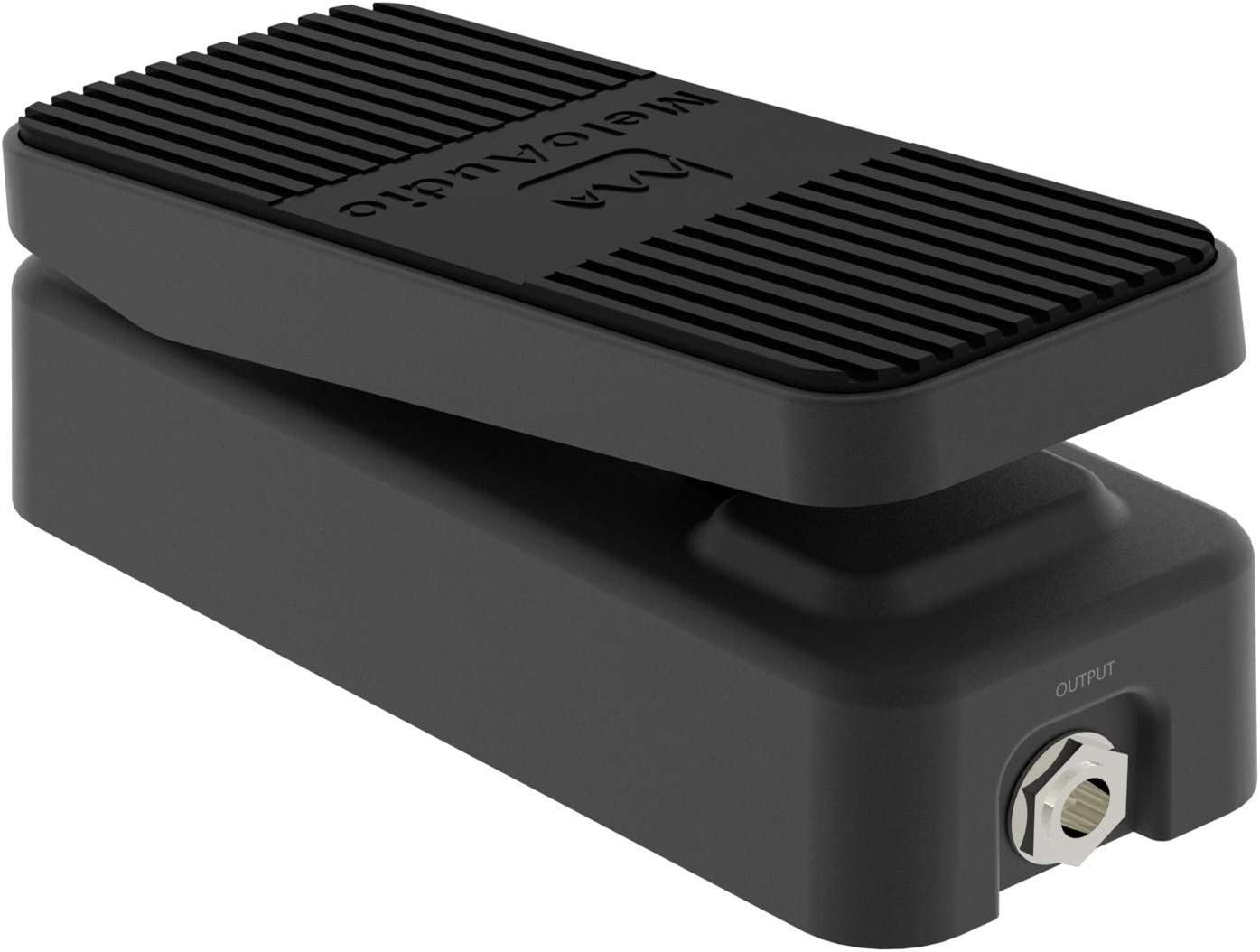
The MeloAudio EXP-001 Expression Pedal could be the perfect tool for musicians searching for a high-fidelity audio accessory.
Its streamlined pedal movement offers unparalleled control and comfort, accommodating the most discerning of players.
Don’t worry about slipping out of position; its design includes a damping pedal shaft that remains at a predetermined angle unless deliberately adjusted.
Space on your mounting plate will be no issue.
Its compact design ensures an easy fit, even amidst other effects.
The build quality is impressive, too; cast aluminum housing provides reliable durability, while a rubber-coated pedal ensures non-slip play and heightened comfort.
Compatibility? It’s got you covered.
Whether you prefer the TS MEGA, MIDI COMMANDER, Fractal AXE Fx2, or any other effect with a standard TRS expression input, the EXP-001 will work seamlessly.
It’s just another innovation from Meloaudio, a brand with a rich history in high-quality audio design since its inception in 2015.
- My Review
My experience with the MeloAudio EXP-001 Expression Pedal has been rather satisfying.
Regarding its compact design, I’ve found it to be an undeniable advantage.
It’s a space-saver that doesn’t compromise on functionality, a characteristic that is a godsend when dealing with a crowded effects pedal setup.
Immersing myself in the smooth functionality of the pedal movement was a unique encounter.
It caters to the innate desire for control and comfort that musicians like me tend to crave.
It’s been my ally, allowing me to express the nuances of my playing style without getting in the way.
The pedal’s stability caught my attention; it remained at a chosen angle unless I decided to shift it.
That’s a testimony to its damping design – a thoughtful feature that echoes MeloAudio’s commitment to high-quality audio product designs.
The product’s compatibility is indeed impressive.
I’ve tried it with several effects, all with standard TRS expression inputs, and it performed flawlessly.
It’s that versatile piece of kit that glides into your setup and works, irrespective of the brand or model of the effect.
A small critique, however, lies in the initial acclimation to the rubber-coated pedal.
While it offers non-slip play and superior comfort, the texture can take a moment to get used to.
However, once you’ve adjusted, it adds to the overall precision response of the pedal.
Finally, its durable cast aluminum housing signifies its long-term endurance, ensuring your investment doesn’t go amiss.
Here are the ratings I’ll give to the MeloAudio EXP-001 Expression Pedal:
The MeloAudio EXP-001 Expression Pedal has proven to be a reliable, comfortable, and efficient device.
It’s a blend of innovative features and solid build quality that makes it a worthy addition to any musician’s gear.
- Pros:
- Ultra-smooth pedal movement.
- Small size for better placement.
- Damping design for specified angle.
- Precision response and smooth action.
- Compatible with various effect models/brands.
- Cons:
- Limited compatibility with certain effect models.
- No built-in power supply.
- May require additional cables/adapters for connectivity.
My final verdict is that the MeloAudio EXP-001 Volume Expression Wah Bass Guitar Effects Pedal is an excellent choice for guitarists and bassists.
With its ultra-smooth pedal movement, small size for better placement, and precision response, it offers great control and comfort.
The pedal’s compatibility with various effect models/brands adds versatility.
Additionally, the brand MeloAudio has a reputation for designing high-fidelity audio products.
Although no specific cons are mentioned, it’s worth noting that the pedal’s compatibility might be limited with certain effect models.
Additionally, it lacks a built-in power supply, and there may be a need for additional cables or adapters for connectivity.
The MeloAudio EXP-001 Volume Expression Wah Bass Guitar Effects Pedal earns a positive verdict considering its overall performance, features, and value.
It offers many tonal possibilities and is a reliable option for musicians seeking a quality effects pedal for their guitar or bass.
Electro-Harmonix Single Output Expression Pedal
Versatile, affordable expression pedal with adjustable range.
EHX Expression Pedal is an affordable, single-output expression pedal with a TRS polarity switch, reverse button, and range knob for customizing expression control. Its TRS out jack connects to devices with an expression input for versatile control.
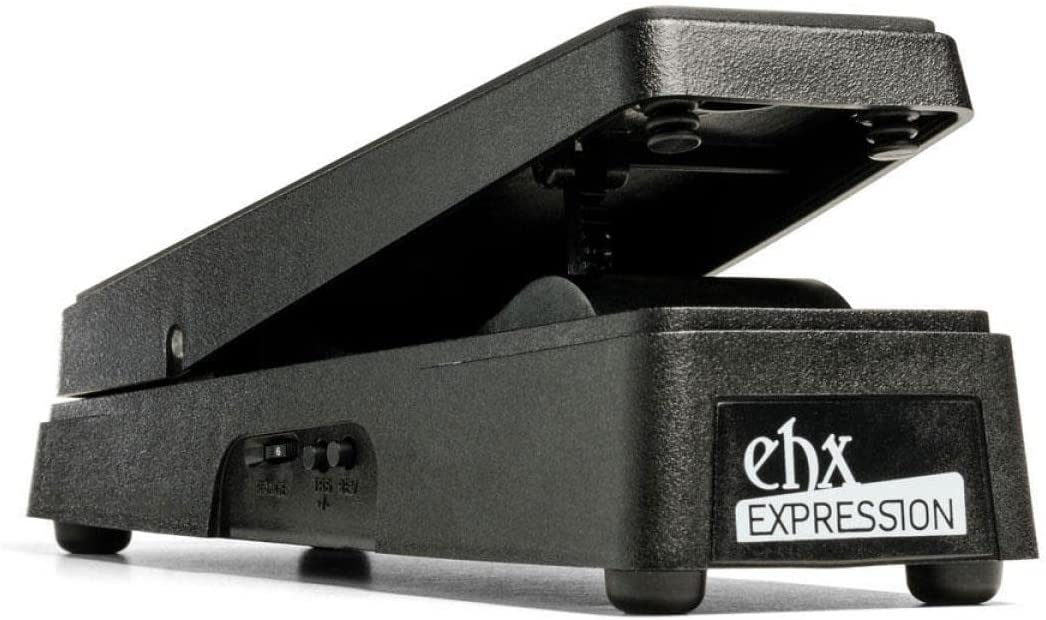
Meet the single-output expression pedal from Electro-Harmonix, designed with the musician’s needs in mind.
This particular pedal stands out for its wide-ranging versatility.
No matter what device you’re using, as long as it has an expression jack, you can rely on this handy pedal for control.
Its affordable price tag makes it a go-to choice for many.
Physically, it’s compact but sturdy, measuring 11 x 4 x 3.5 inches.
Powering it is a breeze with a requirement of only 9 Volts and 25 Milliamps.
Customization is a standout feature of this expression pedal.
You can tweak the expression sweep to your liking using the Range knob.
It also features a handy TRS polarity switch to alternate connections to the TRS jack.
There’s a reverse button on the board, adding another layer of customization by enabling the reversal of the expression pedal’s sweep direction.
Connect a 1/4″ TRS cable to its dedicated TRS Out Jack to control your desired device, enhancing your musical experience.
- My Review
Plugging into the Electro-Harmonix Single Output Expression Pedal for the first time, I immediately noticed its sturdy build.
Its compact dimensions of 11 x 4 x 3.5 inches make its solid construction impressive.
I found this pedal a real power-saver, needing just 9 Volts and 25 Milliamps to function.
The standout point is that it’s more than just another pedal.
The ease with which it integrated into my setup was notable.
As long as an expression jack is on the device, this pedal takes command without hassle.
Its broad compatibility and control abilities are undeniably valuable.
The affordability of this pedal is another advantage, making it a real workhorse accessible to all.
Flexibility is key in the world of music, and that’s where the Range knob and TRS +/- Button shine.
They allowed me to adjust the expresexpression pedal’s minimum setting and change the TRS jack’s polaritysignificantly to the customizability of my setup.
I found the versatility of the pedal commendable.
One feature that particularly caught my attention was the Reverse button.
The ability to alter the sweep direction of the expression pedal offered a level of control that I appreciated.
Including a dedicated TRS Out Jack for a 1/4,” TRS cable was a thoughtful touch, simplifying the connection to my device.
On a critical note, there might be a bit of a learning curve for beginners to leverage its features fully.
Here are the ratings I’ll give to the Electro-Harmonix Single Output Expression Pedal:
However, once understood, it’s clear that Electro-Harmonix has designed a pedal with a keen eye for the requirements of a dynamic music environment.
This pedal may be a versatile and cost-effective tool that could make a real difference in your musical experience.
- Pros:
- Versatile functionality.
- Affordable price.
- Compatible with various devices.
- Cons:
- Limited durability.
- No LED indicator.
- Requires 9-volt power supply.
My final verdict is that the Electro-Harmonix Single Output Expression Pedal is a highly versatile and feature-rich pedal.
With its compatibility with various devices, affordable price, and strong brand reputation, it offers a great value for musicians.
While it may have some minor drawbacks such as limited durability and the absence of an LED indicator, its overall performance is commendable.
Therefore, I would recommend considering this pedal for those seeking a versatile expression pedal option.
MOOER Expline Guitar Expression Pedal
Smooth, precise control with dual output for any brand.
EMG T SYSTEM is a prewired Telecaster guitar pickup set that provides bright, responsive, and noiseless sound. Its solderless installation makes it easy to upgrade existing Tele style guitars with the included components.
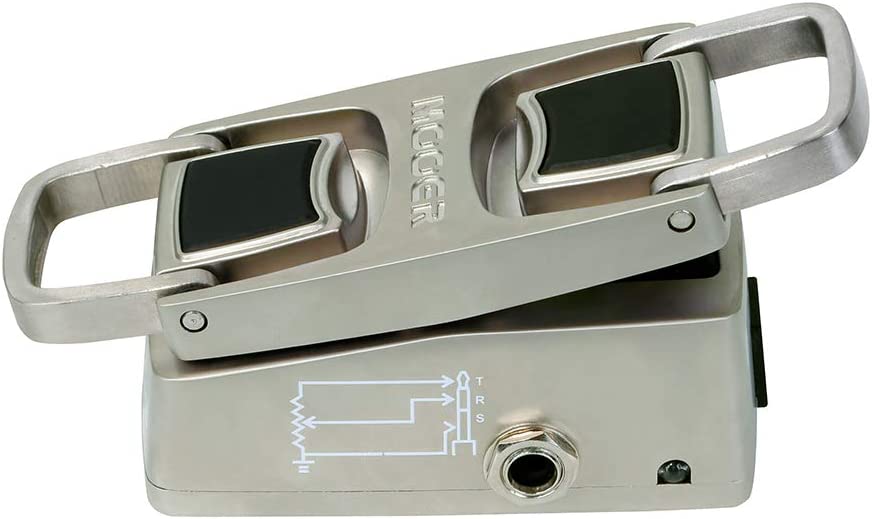
Boasting a micro-size design, this petite dynamo ensures accurate and smooth control, essential for fine-tuning your musical output.
Its compact size, weighing just half a kilogram, doesn’t compromise its utility.
On the contrary, it enhances its portability, making it a handy companion for musicians on the move.
Uniquely, Expline offers two output options.
Why, you ask? It ensures compatibility with a broad range of equipment from numerous brands.
Yes, MOOER has thought about diverse user needs with this design!
Its style and color, aptly named Expline, radiate a distinctive charm, adding a touch of class to your musical ensemble.
Powering it up requires a 9-volt supply, aligning it with standard pedal power specs.
- My Review
Stepping into the music world with the MOOER Expline guitar expression pedal was a uniquely engaging experience.
Crafted with precision, it brings functionality into a compact, lightweight form.
Weighing in at only half a kilogram, it was an effortless addition to my setup.
The diminutive size was surprisingly refreshing, a welcome departure from the usual heft of other pedals.
Unboxing this expressive companion, the first thing that struck me was its distinct color and style, aptly named Expline.
Its look quietly hints at its promise – an unconventional, versatile tool ready to elevate your musical journey.
From my first interaction with Expline, the smoothness of control was an absolute delight.
It enabled me to fine-tune my output effortlessly, amplifying the intricacies of the sound I sought.
The experience was akin to having an extra degree of musical expressiveness.
The intelligent design of two different outputs made this experience even more seamless.
MOOER seemingly put considerable thought into catering to diverse musical setups, as evidenced by Expline’s compatibility with various equipment brands.
A testament to its versatility!
Operating on a standard 9-volt supply, it smoothly integrated into my gear without demanding special power arrangements.
A feature that may seem mundane yet essential to a hassle-free performance or practice session.
While the MOOER Expline did impress me greatly with its functionality and design, it wasn’t without its quirks.
It took some time to get used to the smaller form factor, and the learning curve for optimum utilization was slightly steeper than anticipated.
Nonetheless, after the initial adjustments, it was a joy to use.
Here are the ratings I’ll give to the MOOER Expline Guitar Expression Pedal:
My journey with Explineproved to be a reliable companion, amplifying my expression without overshadowing my individuality.
It is more than just a pedal; it is a versatile tool that enhances the musical narrative with nuanced control and compact convenience.
- Pros:
- Micro-sized for portability.
- Smooth and precise control.
- Compatible with various gear brands.
- Cons:
- Potential compatibility issues with certain equipment.
- Limited control options due to small size.
- May require additional power supply (9 volts).
My final verdict is that the MOOER Expline Guitar Expression Pedal is an excellent choice for guitarists seeking a compact and reliable expression pedal.
With its micro-sized design, it offers portability without compromising on smooth and precise control.
The pedal’s compatibility with various gear brands ensures flexibility in integrating it into different setups.
While there may be potential compatibility issues with certain equipment and limited control options due to its size, the overall performance, tone quality, and brand reputation make it a valuable addition to any guitarist’s setup.
Considering its features and value, I highly recommend the MOOER Expline Guitar Expression Pedal.
Digitech Guitar Expression Pedal
Compact, versatile, and reliable expression pedal.
The DOD Mini Expression Pedal offers a compact design with rugged steel construction and gear drive for reliable performance. It has a TRS/TS/RTS selector for compatibility with most gear, and non-slip rubber pads for a secure grip.
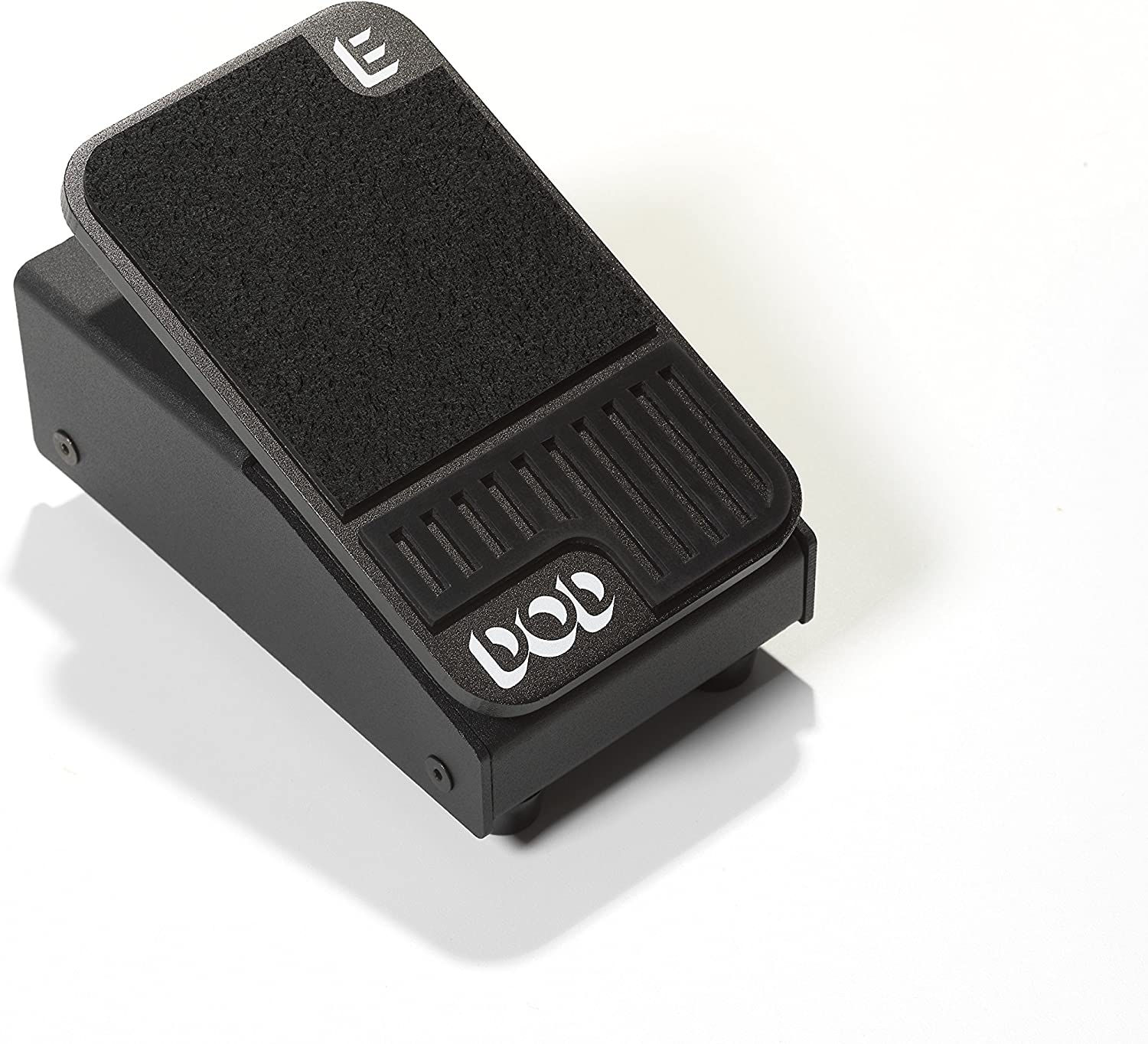
Now let’s chat about the DigiTech Guitar Expression Pedal.
It’s designed with a TRS/TS/RTS selector, allowing it to mesh with just about any rig that accepts expression pedal inputs.
This clever selector makes it adaptable and ready to play a role in creating your perfect sound.
Despite its small footprint, matching most standard pedals, it doesn’t compromise on performance.
It’s engineered to have the same throw and feel as pedals twice its size.
Adjustable resistance, achieved through a 3-position multi-resistance, broadens the range of compatible gear.
Durability isn’t an afterthought for DigiTech.
This pedal is enveloped in rugged all-steel, and its gear drive eliminates the need for strings prone to breaking.
It’s a black beauty elegantly designed by DB Instrument Amp to withstand the test of time.
DigiTech smartly laid non-slip rubber pads to enhance its stability, letting you step without worry.
- My Review
Let me tell you about the DigiTech Guitar Expression Pedal.
It’s this neat little thing, but don’t let its size fool you.
It’s packed with features.
You get this versatile TRS/TS/RTS selector that slaps compatibility issues in the face.
You can plug it into practically any gear accommodating an expression pedal.
What caught my attention was its inconspicuous size.
It blends well with the pedal board and doesn’t demand extra attention, behaving just like one of the big guys.
Sometimes, compact form factors end up feeling flimsy but not this pedal.
It surprises you with the same feel and throws as bigger pedals.
It’s not trying too hard; it naturally stands up to its larger counterparts.
If you’re worried about durability, let that thought slide.
It flaunts a robust all-steel build like it’s going out of fashion.
Don’t you like strings that break? Well, it doesn’t either.
That’s why it opted for a gear drive.
And you know what? It fills you with confidence whenever you step onto its non-slip rubber pads.
One thing some might argue is its slightly heavy footprint on the pedal board, not cumbersome, but potent enough to make its presence known.
Also, some more color choices would’ve added a hint of personalization.
Black does hold its charm, right? So, my take on the DigiTech Guitar Expression Pedal is that it’s a compact yet potent device.
It wears an unassuming look but delivers a powerhouse performance.
Here are the ratings I’ll give to the Digitech Guitar Expression Pedal:
Sure, it’s got a couple of quirks, but then again, what doesn’t?
Despite these, it stands tall, ready to rock your rig!
- Pros:
- Highly adaptable with TRS/TS/RTS selector.
- Comes in an ultra-compact size.
- Robust construction for longevity.
- Cons:
- May be too small for some users.
- No color options available.
- Courses a slight weight to the pedal board.
My final verdict is that the Digitech Guitar Expression Pedal is a highly versatile and feature-rich option for guitarists.
With its compact size, durable construction, and flexible compatibility, it offers excellent performance and a wide range of tonal possibilities.
The reputation of the DigiTech brand adds to its credibility, and considering its overall value, it is a recommended choice for guitar players needing an expression pedal.
Mission Engineering Inc SP-1 Expression Pedal
Offers reliable and versatile control for digital amps, MIDI controllers, and effects.
This expression pedal offers reliability and durability, allowing you to control up to three parameters on multiple instruments simultaneously. It has intuitive design, heavy-duty metal construction, and a non-slip rubber base for stability.
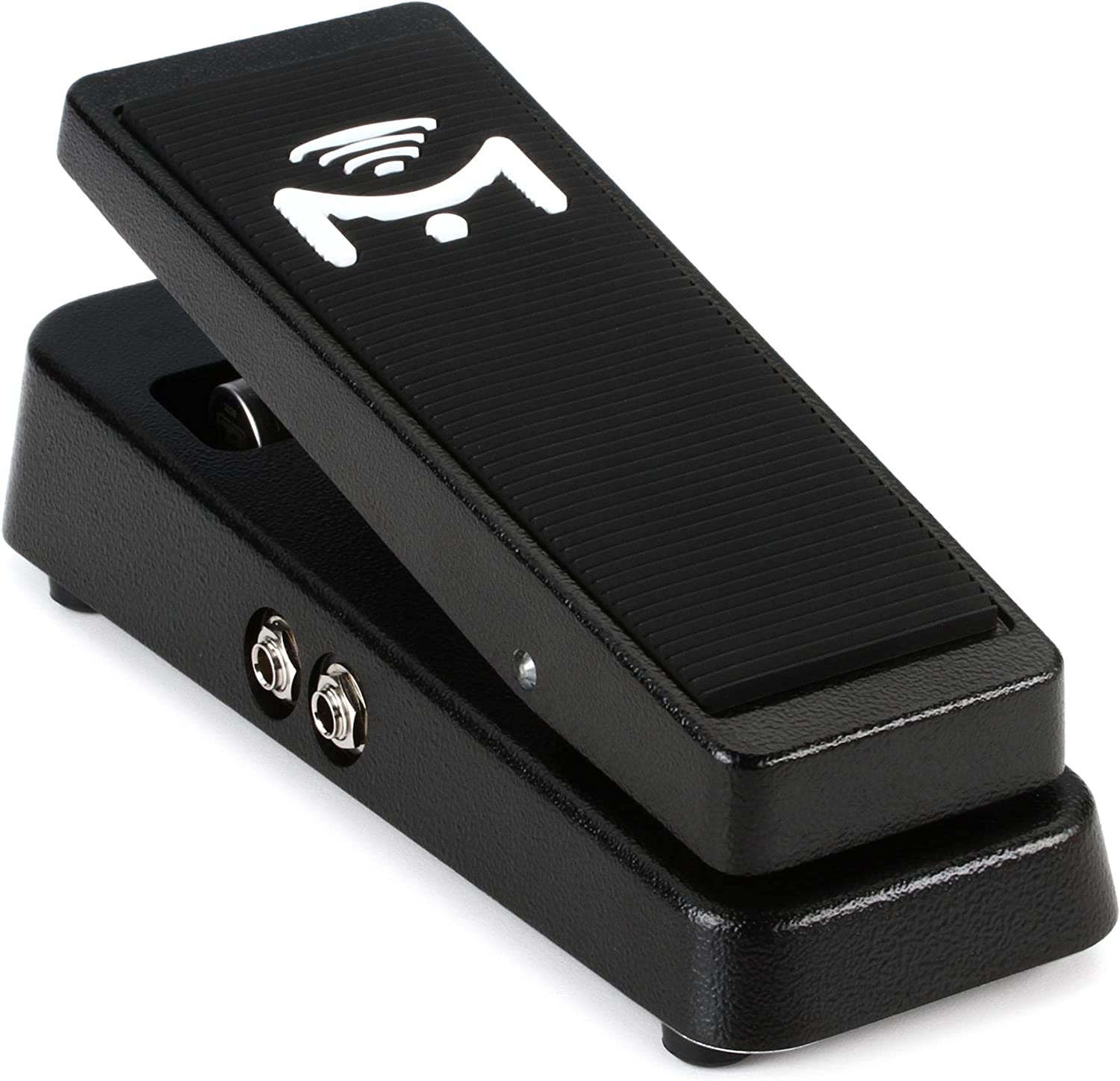
This product is an expression pedal known as the Mission Engineering SP-1.
It’s a dual-function device crafted to cater to your creative needs.
When you think about versatility, the SP-1 may be the ticket.
It’s designed to work seamlessly with digital amps, MIDI controllers, and other effects units.
But what makes the expression pedal stand out?
It’s the incorporated latching footswitch – a feature that adds depth to its functionality.
The pedal’s design is robust and reliable, promising longevity and consistent performance.
This multi-tiered expression pedal bridges various digital devices in your rig and helping you create a holistic sound environment.
Crafted by Mission Engineering, the SP-1 justifies the brand’s commitment to producing high-quality gear for musicians.
So whether you’re a seasoned professional or a newbie tinkering with your sound setup, the SP-1 can be an excellent tool.
- My Review
Stepping onto the Mission Engineering SP-1 Expression Pedal for the first time, I couldn’t help but admire its rugged build.
There was a legitimate sense of robustness, which whispers promises like reliability and longevity.
This pedal doesn’t just look the part; it seems made for the long haul.
As I engaged the latching footswitch, the pedal seamlessly transitioned between digital amps, MIDI controllers, and effects units.
This elevated its role from a mere accessory to a central part of my sound setup.
The dual functionality truly places it a notch above its peers.
The pedal is designed to work flawlessly with a wide array of digital devices to add stripes to its versatility.
This isn’t a one-trick pony; it’s so much more.
Moving on to its performance, I was thoroughly impressed.
The pedal’s output was smooth and consistent, proving it wasn’t just impressively built and capable of stellar performance.
Creating sound was as effortless as I had hoped it would be.
This expression pedal did not disappoint; it played its part with dedication and skill.
I was also given a little extra with the brand’s reputation.
Mission Engineering’s dedication to crafting high-quality gear for musicians was evident in this product.
The SP-1 was a testament to their excellence.
On the flip side, the pedal is challenging for novices to grasp.
It’s not the simplest tool to master and can initially seem intimidating.
Its functionality, while expansive, doesn’t match the precision of more specialized pedals.
But regardless of its minor drawbacks, the Mission Engineering SP-1 was an influential part of my sound setup.
Here are the ratings I’ll give to the Mission Engineering Inc SP-1 Expression Pedal:
Its reliability and multi-tiered functionality made it a crucial tool in shaping sound.
It provided value, offered versatility, and delivered performance – more than what many other pedals on the market can say.
- Pros:
- Rugged and reliable product.
- Multi-function expression pedal.
- Useful for different digital devices.
- Cons:
- May not be suitable for analog devices.
- Limited functions compared to specialized pedals.
- Can be complex for beginners.
My final verdict is that the Mission Engineering SP-1 Expression Pedal with Latching Footswitch appears robust and versatile.
The ability to serve different digital devices marks it high on versatility, and the brand credibility assures good performance.
However, if one is looking for super-specialized features or is new to using such devices, they might want to explore before making a decision.
The pedal seems like a solid choice with decent value for money.
Nektar NX-P Expression Pedal
Solid, reliable expression pedal with polarity switching for universal compatibility.
Nektar NX-P expression pedal is designed for both studio and stage use, featuring rubber gripping and polarity switching for compatibility with most keyboards and controllers. Perfect for precise control of volume, modulation, and other parameters.
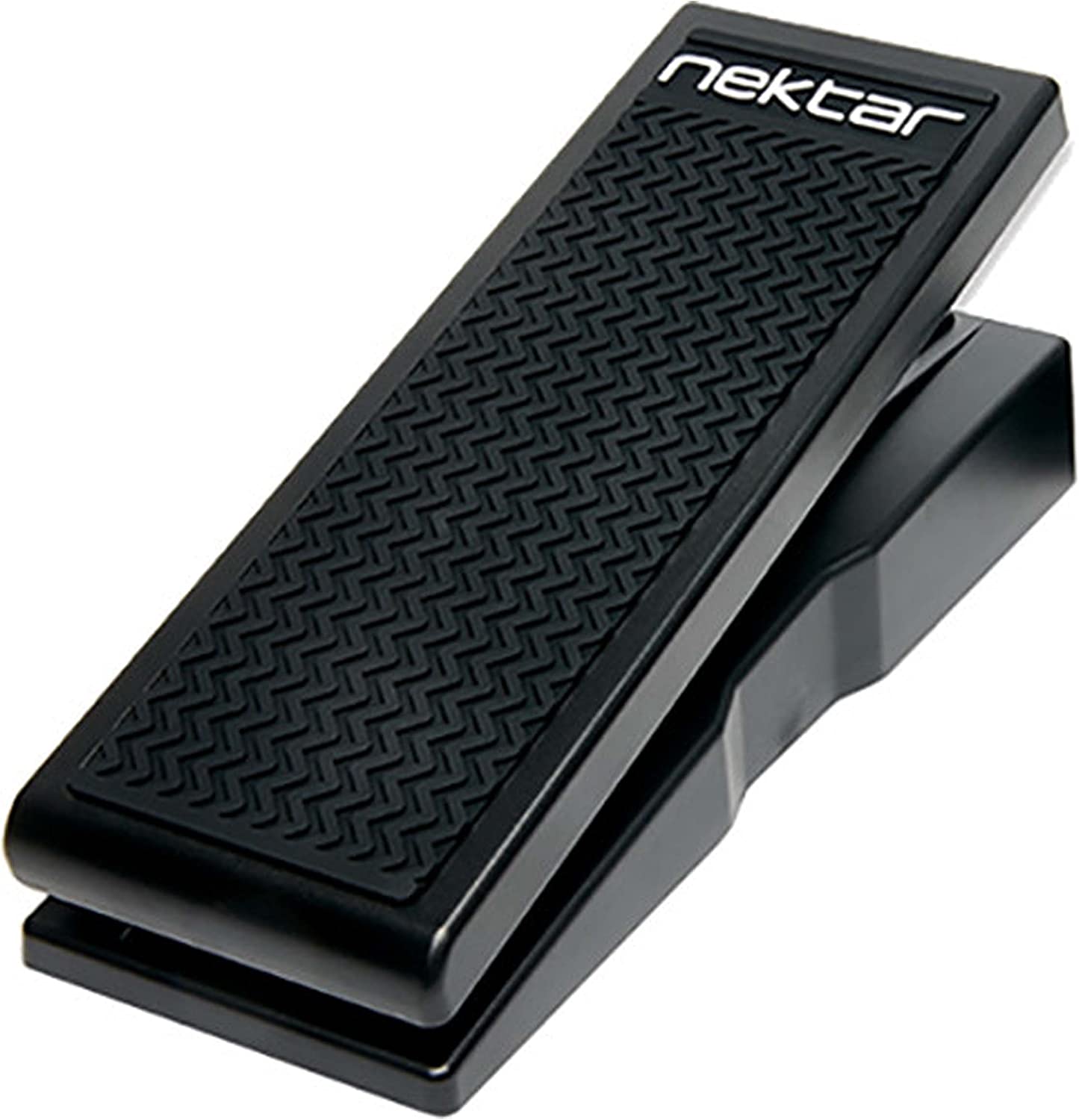
Pedal to the metal with the Nektar NX-P!
This compact, no-nonsense expression pedal is suitable for virtually any device requiring pedal control.
Aiming to cater to various gears, it’s built with a universal compatibility feature that handles most expression pedal sockets.
The compact, sleek black design ensures it won’t take up too much space on your stage or studio setup.
It also boasts an impressive, sturdy nature, thanks to its rubberized finishing on top and bottom, which helps it hold its ground during intense performances.
For a more tailored response, you have a sensitivity Pot and the added convenience of a polarity switch, broadening the range of keyboards and electronic products it can work with.
Tipping the scale at just 454 grams, it’s a small package delivering big value, giving, whether in-studio or performing live, a reliable control option.
- My Review
What an experience with the Nektar NX-P expression pedal!
Reliability struck me first – the pedal is just staunch, seemingly built like a tank, capable of handling studio recording sessions and intense stage performances.
Its sturdy rubberized finish ensures a solid grip, guaranteeing that it wouldn’t slip during those high-stakes moments in a performance, no matter how aggressive my footwork got.
Couple this with a neat and compact size, making it frank in any setup, and a partner there when you need it.
Some may argue that its size might be too small or its black color too plain, but these become minor nitpicks against its ease of use and performance.
Jumping on to its unique features, it’s truly universal.
This pedal comfortably accepts a variety of expression pedal sockets.
Smooth expression transition was a breeze, thanks to the included sensitivity knob, allowing me to fine-tune my response preference.
Plus, the polarity switch remarkably broadens its compatibility.
Whether a synthesizer, a MIDI controller, or even diverse electronic products needed a handy expression control, Nektar NX-P was up to the task.
However, a drawback I noticed was the lack of detailed warranty information.
It’s such a vital piece of gear, and knowing more about the warranty could reassure the users planning a long-term commitment.
On balance, this NX-P punches above its weight, tipping towards a great lightweight performer at just 454 grams, delivering a surprisingly robust experience.
It’s the size of a paperback book but an expression control heavyweight.
Here are the ratings I’ll give to the Nektar NX-P Expression Pedal:
A subtle yet significant impact-maker, whether you are rehearsing in your basement or jamming on a grand stage.
Nektar NX-P dares you to push its limits; it’s simply game for anything.
- Pros:
- Universal compatibility with expression pedal sockets.
- Features robust design with solid floor-grip.
- Comes with sensitive Pot and polarity switch.
- Cons:
- Compact size could be small for some users.
- The absence of color variations.
- No information provided on warranty.
My final verdict is that the Nektar Expression Pedal (NX-P) is an excellent choice for versatility and performance.
It has a robust design and universal compatibility, scoring high in versatility, features, tone, and performance.
The brand is well-established, but the lack of color variation and warranty information might make some potential customers hesitate.
Nevertheless, its value for money is arguably one of the best in its category.
Moog EP-3 Expression Pedal
Robust, reliable expression pedal with smooth performance and customizable accessories.
The EP-3 is an expression pedal designed for use with any keyboard, synthesizer, or pedal with an expression or CV input. It features a durable cam system, polarity switch, scalable output knob, and a front panel ¼ jack for custom cable length.
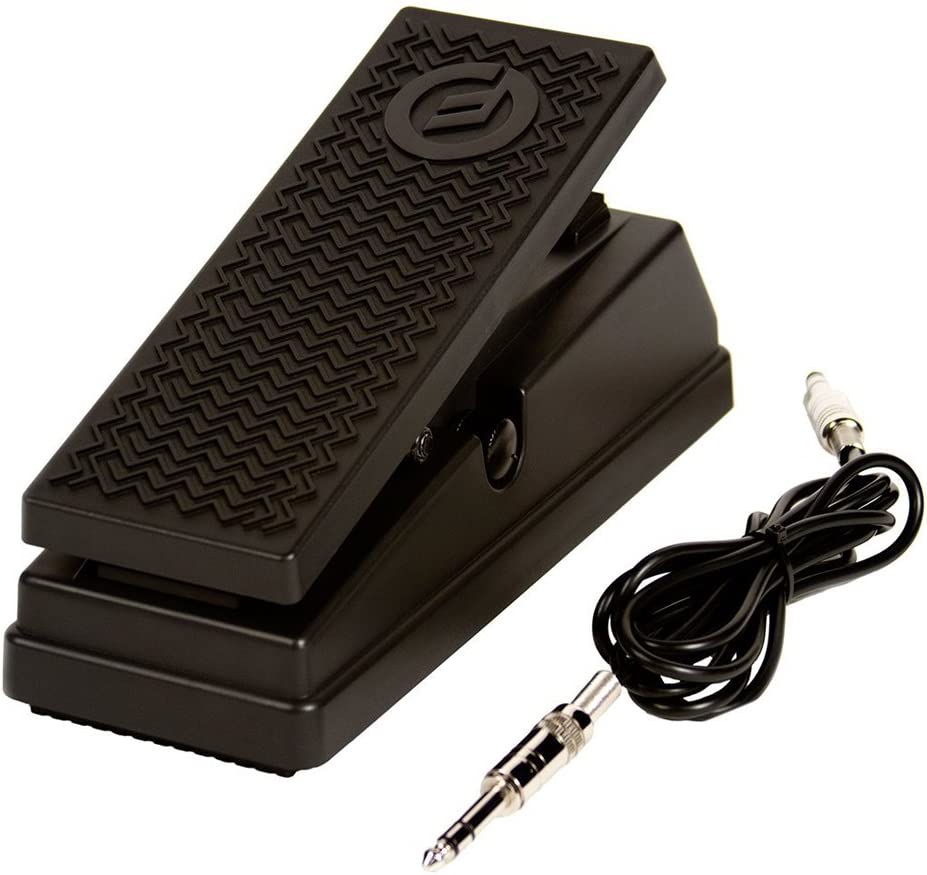
If you’re after a sturdy, adaptable expression pedal, the Moog EP-3 has got you covered.
This meticulously crafted piece is engineered to pair seamlessly with any keyboard, synth, or pedal that boasts an expression or CV input.
The cam system design is a standout, offering a smooth experience that’s as durable as they come.
It’s even been fitted with a polarity switch, a nifty feature that opens up compatibility with non-Moog gear.
Want to specify the musical range? The output knob can handle that for you.
Plus, it has a ¼” front panel output jack, so you can choose to either use the supplied 6.5ft cable or go ahead and find the perfect cable length for your setup.
Compact and weighing in at 2 pounds, the Moog EP-3 is a must-have addition to your musical arsenal.
It’s built to endure heavy use and touring while delivering unrivaled musical precision.
- My Review
Exploring the Moog EP-3 Expression Pedal has been a treat.
Holding it in my hands, I immediately felt the weight – a sturdy piece ready for some heavy playing.
At 2 pounds, it’s slightly heavier than some of its competitors, but it balances out with its compact size and the overall feel of robustness.
I was quite impressed by the beautifully imagined features.
The cam system design is an absolute winner, delivering a smooth performance that stands out in terms of durability.
It’s readily apparent that a great deal of thought has been put into this design, creating a product resilient enough to withstand rigorous daily use and the sometimes less-than-gentle rigors of touring.
When I hooked it up with my gear, it was smooth sailing.
Thanks to its universal design, any keyboard, synthesizer, or pedal with an expression or CV input would connect flawlessly.
Now that’s what I call versatility!
Yet, the product isn’t without its quirks. The cable system took a bit of a learning curve.
The 1/4″ output jack on the front panel allows for flexibility in choosing your cable length, but it might take some time to get it right for the uninitiated.
Thankfully, a 6.5ft cable accompanies the pedal, which adequately serves most needs.
Another noteworthy detail – is the nifty polarity switch.
It hits the mark regarding compatibility, even syncing seamlessly with non-Moog products.
Also, the scalable output knob, an innovative feature aimed at specifying your musical range, adds another level of adaptability.
The Moog EP-3 Expression Pedal is a reliable, meticulously crafted pedal that is wonderfully equipped for delivering precise and expressive musical performance.
Here are the ratings I’ll give to the Moog EP-3 Expression Pedal:
Sure, it might be a bit heavyweight, and the cable system could be tricky for some, but its strong points far outweigh these minor issues.
An worthy addition to any musician’s toolkit, I say.
- Pros:
- Robust, universal and reliable pedal.
- Newly designed cam system for smooth performance.
- Polarity switch ensures wide compatibility.
- Cons:
- Potential for cable length issues.
- Heavier weight compared to some pedals.
- Specific brand compatibility might be queried.
My final verdict is that the Moog EP-3 Expression Pedal is highly reliable and versatile for musicians.
Its design and features make it compatible with a wide range of other music equipment, which offers great value for its price.
Its strong performance, high-quality tone, and the reputation of the Moog brand make this product an excellent choice.
What exactly is an expression pedal?
An expression pedal is an essential tool used by musicians, especially guitarists, keyboardists, and bassists, to modulate and manipulate the sound of their instruments.
The essence of an expression pedal is its ability to modify and express nuances in sound volume, tone, or rate during a live performance or recording session in real-time.
An expression pedal looks similar to a volume pedal, which is also used by musicians to control the loudness of their instruments.

However, an expression pedal has a much wider range of functions.
While a volume pedal adjusts the clean level of an instrument’s output, the expression pedal fine-tunes the sound properties of the instrument by smoothly transitioning between different parameter values of an effect, such as delay time, reverb level, and tremolo speed.
When connected to a compatible device, the expression pedal mimics the knob or dial function that controls a specific parameter.
When you rock the pedal back and forth, it virtually ‘turns the knob’ from the minimum to the maximum of its range.
The best part about using an expression pedal is its instantaneous nature that allows the performer to alter the sound while using their hands to play their instrument, thus adding a dynamic and unique element to their performance.
These pedals are generally compatible with various musical devices, including multi-effects processors, standalone effects pedals, digital pianos, synthesizers, and MIDI controllers.
The way the expression pedal works is quite fascinating.
The pedal controls certain aspects of the sound by applying resistance to a control voltage generated by the connected device.
The pedal adjustment changes the resistance, which then modifies the control voltage.
This change in control voltage then affects the characteristic of the sound being processed, allowing musicians to adjust the sound quality without stopping their performance.
Expression pedals offer a more tactile connection to your instrument or effects.
By engaging the foot in the performance, musicians can extract a truly unique, personal sound and enhance the dynamics and expression of their music.
The range of effects achievable through an expression pedal virtually adds another dimension to the instrument.
There is significant diversity in the types and quality of expression pedals available.
Some pedals only have the basic feature of controlling a single parameter of an effect.
In contrast, others can be used to modulate various signal types and effects and often come with multiple outputs for controlling numerous devices at once.
The materials used in their production also vary, influencing the pedal’s durability, feel, and precision.
Many high-quality expression pedals offer adjustable tension, allowing musicians to customize the feel and response of the pedal to their preference.
Integrating expression pedals with digital modeling processors has taken their functionality to a different level.
The multi-effects processors can digitally imitate the sounds produced by various popular amplifiers, cabinets, and effects units.
When used with an expression pedal, these processors can generate an incredibly wide range of effects that can be manipulated in real-time.
One of the critical factors while choosing an expression pedal is ensuring compatibility with the device it will be controlling.
The voltage requirements, the type of potentiometer, wiring configuration, and physical connectivity options can differ across different makes and models, and these factors need to be considered while choosing the right expression pedal for your setup.
What to consider when choosing an expression pedal?
Choosing the right expression pedal for volume, wah, or any other effect is no simple task.
Many factors need to be taken into account before you make your decision.
This guide aims to provide an in-depth analysis of the key aspects to consider when purchasing expression pedals to ensure you make the right choice for your specific needs and preferences.
– Sound quality

First and foremost, the ultimate determinant of any real musical gadget is sound quality.
After all, the primary goal of any performer is to provide their listeners with the best possible musical experience.
When choosing an expression pedal, keeping the sound quality top of mind is crucial.
That being said, the sound quality of expression pedals can be quite subjective.
Each pedal will color your tone differently, adding its distinct flavor.

The best way to assess sound quality is by testing different models, trying them out with your usual gear, and making sure that the pedal complements your playing style and music genre.
An expression pedal might sound great when used with a Strat playing blues but might not cut it with a Les Paul for hard rock.
While many companies boast superior sound quality, giving the pedal a trial in a live performance setting will let you know of noise levels and responsiveness.
It will help you consider if its sound warms up nicely to your gear or if it creeps unwanted noise into your system.
– Controls and features

When choosing an expression pedal, please pay close attention to the controls and features they offer.
Some pedals may offer adjustable parameters that let you precisely control the effect’s intensity or the speed of the sweep.
Some also come with an onboard tuner, built-in boosts, or additional outputs.
For instance, you may want a pedal that can switch quickly between several different expression effects without bending over and fumbling with knobs.
You might also want an expression pedal with a bypass switch, allowing you to exclude it from your signal chain when it’s not in use for a cleaner sound.
Considering the controls and features becomes increasingly important, especially when you foresee usage for an extended play, live gigs, or some intense expression effects while recording.
– Analog vs. Digital
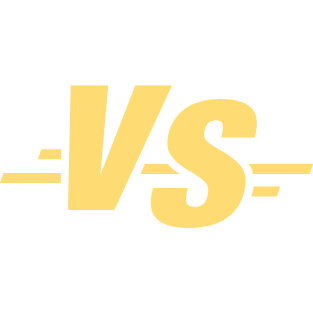
Expression pedals generally come in either analog or digital form.
Each of these has unique specifications and contributeso to the overall sound quality and impression differently.
Analog expression pedals offer rich, warm, and naturally-occurring sounds.
They have a certain authenticity to them that serious musicians appreciate.

Analog pedals employ physical potentiometers to regulate effect variables – a detail that carries its charm, albeit also presenting issues with wear over extended periods.
Alternatively, digital expression pedals employ digital circuits to recreate effects.
This configuration excels in ease of manipulation, vast effect types, and consistency.
Typically more durable, digital pedals are less sensitive to external elements and decay slower over time.
While musicians’ opinions are divided on this topic, most will agree that digital pedals fail to replicate the warmth and randomness of their analog counterparts fully.
A fundamental grasp of this discussion can steadily guide your preferred choice based on authentic sound, resilience, and versatility requirements.
– Build quality and durability

Building quality often ranks highly among the set of considerations when procuring an expression pedal.
Pedals, especially those used for live performances, should endure rigorous foot-stomps, periodic shuffling between gig venues, and the possible mishaps of spilled liquids.
Expressional pedals come in a range of builds.
Some might be composed of solid metal encasing providing lasting robustness, while others made of plastic might not fare as well under stress – yet are feather-light and easier to maneuver.
Expression pedals with metal construction, while providing durability, might be heavier and cumbersome.
Conversely, more lightweight options fashioned from hardy plastic hybrids may not provide the long-term durability metal offers yet are more suited to regular transit conditions.
Remember, durability and resilience often parallel cost – more robustly constructed pedals might be heavy on the pocket.
– Presets and versatility

Regarding versatility and complexity, expression pedals range from basic single-effect types offering minimal controls to multi-effect units yielding a suite of customizable features.
Events demanding many effects precariously condensed into a few seconds will benefit from preset banks and intensified versatility.
Expression pedals offering onboard user presets facilitate saving preferred settings, easing the transition between different song sections.
Thus, certainly beneficial to musicians performing more modern genres or requiring an array of effects.
– Brand reputation

Major companies within this industry, such as Electro-Harmonix, Boss, and Fender, stand out for their long-established reputations for quality.
Newer brands, while lacking this history, may often apply innovative features, contemporary technology, and enticing price points.

Selecting expression pedals based on brand reputation might be important if you’re seeking something tested, safe, and reliable.
However, it’s not rare for musicians to spot compatible gem models from emerging brands that sell at low-risk price points, assured, community-recommended, or generally backed by positive reviews.
– Price and budget

While certainly not as forth-front a consideration as sound quality, your budget will eventually influence your final choice.
Expression pedals will range from a modest $30 to high-end builds that might soar over $300.

Start by outlining a realistic and flexible budget frame.
Your financial plan should account for main variables, including purpose, frequency, and intensity of use, existing relevant gear, stature as an artist, and the compatibility of the potential pedal(s) in question.
– Reviews and recommendations

Lastly, consider reviews and recommendations from trusted sources and product demos.
While personal preference ultimately rules, sound advice from experienced music professionals, forums, and peers will make your task easier.
Online or in-store product demos allow for a first-hand experience before purchasing.
Don’t rush; take time to experiment with different pedals, try them with your gear, and see which one meets all your requirements.
How to properly use an expression pedal?
Mastering the use of an expression pedal can dramatically enhance your musical performance.
We will delve into the nuances of using the expression pedal effectively, from understanding its controls to incorporating it into your music.
– Familiarize yourself with the controls and features:
As with any musical technology, the first step is familiarizing yourself with the controls and features of an expression pedal.
Expression pedals, often used by guitarists along with pedalboards, are used to control certain parameters of a musical effect in a hands-free manner.
These pedals usually have a few simple controls: a foot pedal that can be manipulated with your foot’s movements, an input/output for your instrument’s cable, and occasionally a knob to adjust the range of the expression parameter.
The foot pedal’s location and sweep determine the extent of the expression effect applied.
Think of an expression pedal as a potentially variable knob.
The more pressure or movement you apply with your foot shifts, the more expression you contribute to the sound.
The expression can control a wide range of parameters, from volume or gain to the modulation rate of a phaser effect.
More sophisticated expression pedals may also have other functions such as boost, which gives a lead boost to your signal; the tuner, which can help you tune your guitar accurately; a display to show the exact parameter adjustments being enabled.
– Adjust the parameters to suit your musical goals:
Understanding what your expression pedal can do is vital, but applying this to your musical context is where the magic happens.
An essential part of working with an expression pedal is to tweak the parameters to bring out the nuances of your original tone and enhance your performance.
Work on setting the minimum and maximum levels to control how dramatic the effect will be from heel to toe.
Tailoring these settings, as with anything in music, is subjective and will rely on your musical taste, the style of music you’re playing, and what you aim to achieve in your sonic landscape.
For example, if you are a blues guitar player, the popular use of expression pedals is wah or volume swells, which can often provide a touching or intense emotion to your leads.
– Incorporating the expression pedal into your signal chain:
Putting the expression pedal in the right place in your signal chain is part of getting the sound you want.
The placement of effects pedals order significantly impacts the overall sound.
The placement of the expression pedal generally depends on the type of effect you are controlling.
If you’re using your expression pedal to control the gain or distortion, you’ll want to position it before your distortion pedals.
However, If you are using your expression pedal to control a modulation effect such as chorus or phaser, place it after these effect pedals in your signal chain.
Remember that there are no hard and fast rules regarding this; the best configuration will depend on the other units in your chain and how you use them together.
The use of expression pedals necessitates foot control.
This ability may demand a certain level of coordination, especially when you must focus on delivering complex beats on your specific instrument while simultaneously being attuned to the incremental changes you need to provide through your foot movements.
Similar to how you would allocate time and focus on mastering an instrument, it is equally integral to devote an akin amount of time to practicing your control of the pedal with your foot.
This may involve recognizing the amount of weight your foot has to exert on the pedal to create the desired sound effect and learning the subtlety of variations that your foot can make on the pedal, which can range from minor fluctuations for dynamic swells to more assertive stompings for intense dive bombs or robust vibrato tremolos.
In essence, refining your foot coordination with the expression pedal would equip you to bring a diverse sense of musicality and dynamics to your performances.
– Experiment with the sound:
As distinctive as owning an expression pedal can be, remaining open to exploring your expressive voice will set you apart.
Try to use your pedal in creative and unconventional ways.
This could imply using the expression pedal to control an effect you wouldn’t typically associate with an expression pedal.
Experimenting will not only assist you in gaining mastery over controlling your musical expression, but it could also inspire you to create a sound that has uniqueness in the crowd.
– Utilize the pedal in performances:
Many professional musicians depend on expression pedals to deliver nuanced, engaging performances.
Gaining familiarity and comfort with the pedal in a live setting is necessary.
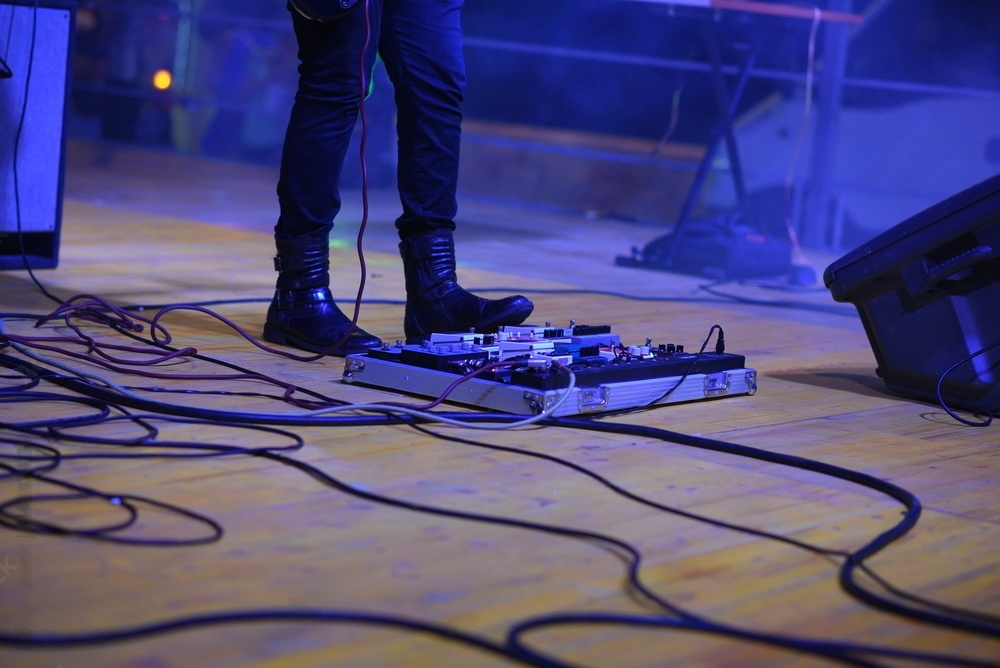
Start by integrating your expression pedal into smaller performances or recordings.
A live concert situation might initially seem intimidating; hence, homely gatherings or band rehearsals allow for the perfect practice platform to start.
As you gradually integrate the pedal interaction into your playing instinctively, it will become more seamless during stage performances – contributing exotically fun elements to your live concerts.
– Regular maintenance:
Like all gear, expression pedals need proper care and maintenance.
Keep the mechanical parts (like the foot rocker) clean and dust-free.
You might also lubricate the moving elements as necessary.
If your expression pedal starts acting weird or instantly drops off the volume, it’s time to inspect the pot.
The maintenance can include keeping it safe during transportation or storing it in a suitable environment.
In addition, using good-quality connecting cables and surveying for any wear or tear to pedal parts contributes to the long service life of an expression pedal.
How to order pedals on a pedalboard?
There is no one-size-fits-all approach to ordering pedals on a pedalboard, as the optimal arrangement largely depends on the specific sound you’re aiming for.
Usually, though, you will see guitar players mostly agreeing with this order:
Tuner > Filters/Dynamics > Pitch-based Effects > Overdrive/Distortion > Modulation > Time-based Effects > Looper
Aside from that, some general guidelines can help you achieve a balanced and versatile setup.
Let’s talk in detail about the order we just mentioned, but feel free to experiment and adjust to your own preferences:
- Tuner: Place your tuner pedal first to ensure your signal is in tune before passing through the other pedals.
- Filters and dynamics: Wah-wah, envelope filters, compressors, EQs, and noise gates should come next. These pedals affect your sound’s dynamic and tonal aspects, so it’s best to place them early in the chain.
- Pitch-based effects: Octavers, harmonizers, and pitch shifters should come after filters and dynamics since these pedals alter the pitch of your signal and work best with a clean, unprocessed sound.
- Overdrive and distortion: Overdrive, distortion, and fuzz pedals typically come next. They shape your guitar’s core sound, and placing them before most other effects ensures that those effects receive a strong, consistent signal.
- Modulation effects: Chorus, flanger, phaser, and tremolo pedals should be placed after overdrive and distortion effects. We do this to allow these pedals to add depth and movement to your sound without becoming overly distorted or overbearing.
- Time-based effects: Delay and reverb pedals should be placed towards the end of your signal chain. This allows them to create a sense of space and depth around the other effects, simulating the sound of a room or hall.
- Looper: If you use a looper pedal, it should be placed last in the chain. This ensures that you’re looping the entire signal, including all the effects you’ve applied.
Remember, these are just general guidelines and what generally works and sounds good.
The most important thing is to experiment and find the arrangement that best suits your personal sound and style.
For example, here’s one pedalboard signal chain that I always use:
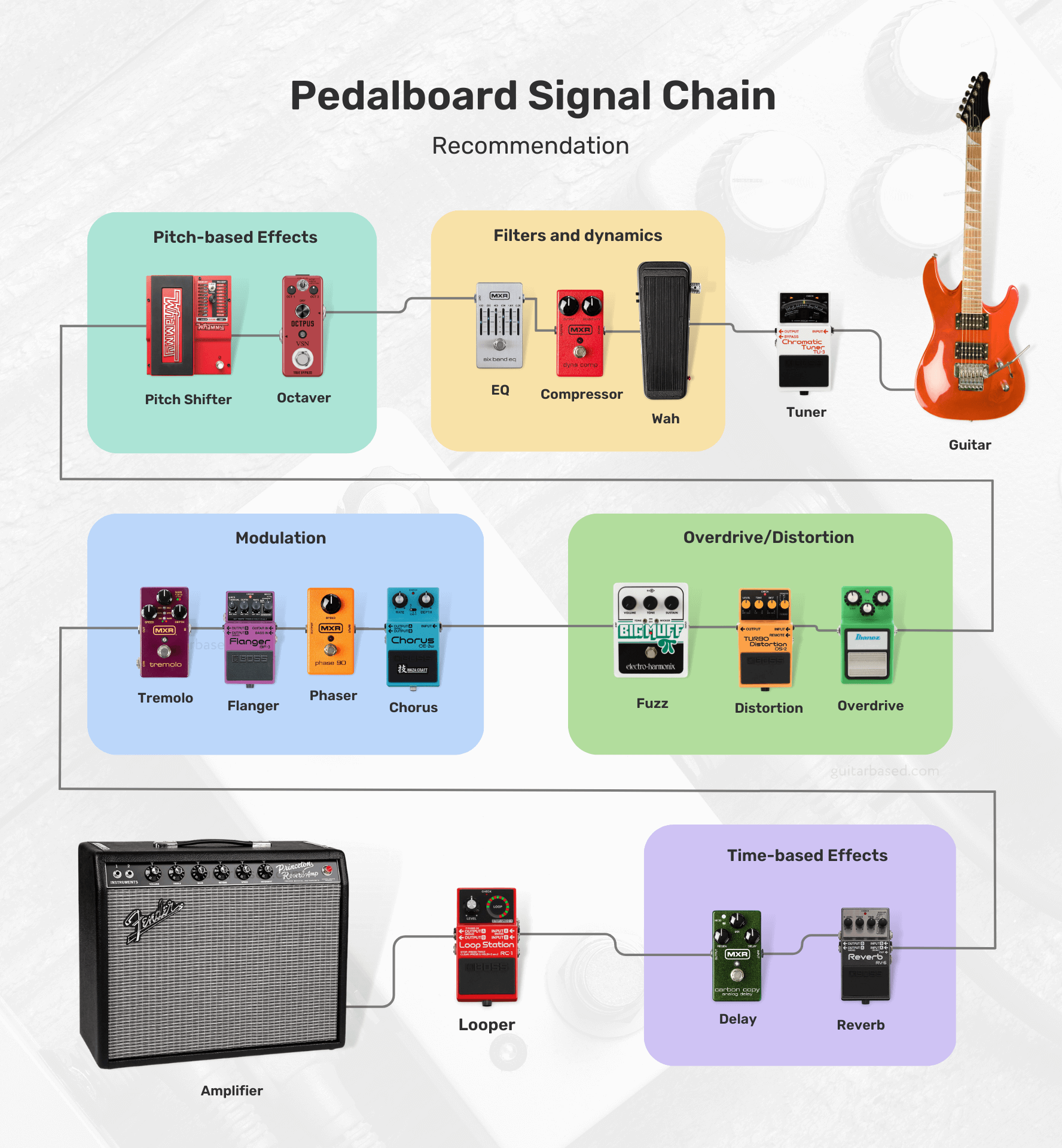
Feel free to swap the order of pedals, try different combinations, and test out unconventional setups until you find the one that works best for you.
For those interested, I’ll leave you with most of the possibilities that you’ll encounter and how to order them.
- Tuner
- Filters/Dynamics:
- Volume
- Wah
- Auto-Wah
- Compressor
- Noise Gate
- EQ (Equalizer)
- Pitch-based Effects:
- Octaver
- Harmonizer
- Pitch Shifter
- Overdrive/Distortion/Fuzz:
- Boost
- Overdrive
- Distortion
- Fuzz
- Modulation:
- Chorus
- Phaser
- Flanger
- Univibe
- Vibrato
- Tremolo
- Time-based Effects:
- Delay
- Echo
- Reverb
- Synth/Bitcrusher:
- Synth
- Bitcrusher
- Acoustic Simulator
- Multi-Effects
- Utility:
- Buffer
- A/B/Y Switcher
- MIDI Controllers
- Looper
Boutique vs. Mass-Produced pedals
Boutique pedals are generally built with higher-quality components and craftsmanship, resulting in better durability and longevity.
These pedals often feature unique and innovative designs, providing a wider range of tones and effects that may not be available in mass-produced options.
Here are a few examples of boutique pedals:

All the manufacturers also tend to have a more personal approach, with better customer service and the ability to customize pedals according to the user’s preferences.
However, boutique pedals are usually more expensive due to the smaller scale of production and the use of premium components.
Mass-produced pedals, on the other hand, are more affordable due to their larger scale of production and the use of cost-effective components.
These pedals are widely available and offer a range of popular effects, making them accessible to a larger audience.
Here are a few examples of mass-produced pedals:

The quality control for mass-produced pedals can vary depending on the brand and model, but many are reliable and offer good value for the money.
As for one of the downsides, you’ll find that mass-produced pedals may not have the same level of uniqueness or innovation as boutique options.
On the other hand, they may not provide the same level of customer service or customization options.
The choice between boutique and mass-produced pedals depends on your personal preferences, budget, and desired sound.
If you’re looking for unique tones, higher-quality components, and a more personal experience, boutique pedals may be the way to go.
But I would say, for those who are on a budget and need access to popular effects, mass-produced pedals might be a better fit.
It’s worth trying out both types to see which best suits your needs and playing style.
How much should you spend on a guitar pedal?
If I were in your position, I would first determine my budget and specific needs before deciding how much to spend on a guitar pedal.
For beginners, it might be more reasonable to start with affordable, mass-produced pedals to explore different effects without spending too much.
Guitar pedals can range in price from around $30 to over $400, depending on the brand, quality, and complexity of the effect.
As your skills and understanding of your preferred tone develop, you can gradually upgrade to higher-quality or boutique pedals.
One thing I would do is consider which effects are essential to your playing style and prioritize purchasing those first.
Allocating a larger portion of your budget to the most important pedals might be a wise choice, especially if you only need a few basic effects.
However, if you require a wide array of effects, you may want to consider more budget-friendly options or multi-effects units.
Keep in mind that higher-priced pedals often come with better build quality, unique features, and improved sound quality.
But I would also say that price is not always directly correlated with quality or suitability for your needs.
Sometimes, a more affordable pedal can deliver the exact sound you’re looking for, while a higher-priced option might not meet your expectations and are only expensive because of the brand reputation.
Can you use a guitar pedal with a bass guitar?
You can certainly use a guitar pedal with a bass guitar.
But it’s crucial to be aware that some guitar pedals may not be specifically designed to accommodate the frequency range of a bass guitar.
This could result in a less-than-ideal performance or an altered tone that might not be what you were expecting.
If you’re feeling adventurous and eager to experiment with your sound, don’t hesitate to connect your guitar pedals to your bass guitar.
This can be a fun way to explore different sonic possibilities, and you might even stumble upon some unique tones that complement your playing style perfectly.
Using a guitar pedal with a bass guitar may not always produce the desired results.
In some cases, the low-end frequencies might be lost, or the effect could sound too harsh or muddy.
To avoid these issues, you could consider looking into pedals that are specifically designed for bass guitars.
These pedals are engineered with the bass frequency range in mind, ensuring that your low-end remains intact and the effect sounds as intended.
In addition to bass-specific pedals, there are also multi-effects processors and pedals that cater to both guitar and bass players, offering a wide range of effects and tonal options.
These versatile units can be a great solution if you play both instruments and want a single device to cover your needs.
How to properly power your pedals?
When it comes to powering your pedals, you want to make sure you’re doing it right to avoid any noise issues or potential damage.
First, check each pedal’s power requirements, which you can usually find in the manual or on the pedal itself.
You’ll want to pay attention to the voltage (usually 9V, 12V, or 18V) and current (measured in milliamps or mA).
Now, you’ve got a few options for powering your pedals.
You can use individual power supplies or batteries for each pedal, but that can get messy and inconvenient.
I’d recommend going for a pedal power supply or an isolated power brick.

For example here are a few ones I recommend:
- Voodoo Lab Pedal Power 2 Plus Isolated Power Supply (My favorite)
- Rowin PW-1 Guitar Pedal Power Supply (Cheapest)
These babies can power multiple pedals at once, and the isolated outputs help prevent noise and ground loop issues.
Just make sure the power supply you choose can handle the voltage and current requirements of all your pedals.
When you’re connecting everything, use good quality power cables and keep them neat and tidy to avoid a tangled mess.
You might even want to use cable ties or cable organizers to keep everything in order.
In love with guitars, and gear; expert in all things music! Been writing about guitars for about 5 years and counting. Born in the ’90s. Alma Mater: University of Havana. Always curious, trying to understand the world. #TeamFender

